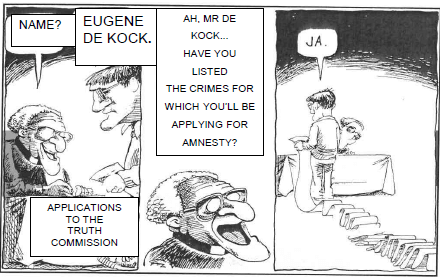Adele
History Paper 2 Addendum - Grade 12 June 2021 Exemplars
ADDENDUM
QUESTION 1: | HOW DID SOUTH AFRICANS REACT TO P.W. BOTHA’S REFORMS IN THE 1980s? |
SOURCE 1A | |
This extract focuses on the reforms implemented by the apartheid regime to transform apartheid. | |
The new Botha administration thus began to transform apartheid. It granted rights to African trade unions and allowed important privileges for the urban workforce, but it was the government’s attempt to create a black middle class that impacted most on Soweto. The government hoped that this class of black people would have too much to lose to help the struggle for liberation. Central to the government’s reform initiative was the reintroduction of 99-year leaseholds. Sowetans were once again allowed to buy rather than rent, newly built houses as well as the older matchbox houses. They could also renovate their homes. The government embarked (started) on an advertising campaign using the slogan, ‘Buy now, improve and feel secure’. Although few houses were sold initially, after new loans were made available to buyers, many houses were SOLD [From Soweto: A History by P Bonner and L Segal] | |
SOURCE 1B |
This extract focuses on the role played by the UDF to resist apartheid. |
A vacuum was created in the townships and ordinary black men and women realised that all South Africans who opposed apartheid now had to unite in a nationalist struggle to force the government to negotiations. It was in this space that important new political figures such as the Reverend Allan Boesak, Albertina Sisulu and Patrick ‘Terror’ Lekota, including many others, came together to launch a new broad anti-apartheid organisation. The United Democratic Front (UDF) was formed on 20 August 1983. The goal of the UDF was to bring together various groups in South Africa who were fighting for the same goal: freedom from the apartheid regime. After the Soweto Uprising more youth, students and workers became involved in the anti-apartheid struggle. Their new tactics of resistance were more aggressive and militant. The UDF wanted to take these changes to the political level and called for change through mass mobilisation and resistance. The UDF operated under the slogan, “People’s Power”, stating that in order to change the political system it must start at the local level. The UDF soon realised that it was very difficult for the state to suppress the multiple local level resistance campaigns, especially their ungovernable tactics of consumer and rent boycotts and protest. In January 1986 the UDF met with the African National Congress to determine in more detail the UDF and its role against the apartheid regime. [From www.ancarchives.co.za. Accessed on 11 May 2021.] |
SOURCE 1C |
This is a poster used by the UDF in its anti-election protest against apartheid in 1984. |
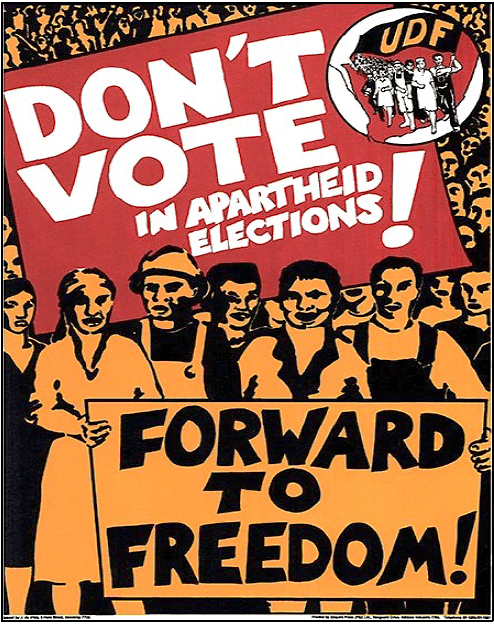 |
[From South Africa-info.com/history/nelson-mandela-timeline/attachment/united-democratic-front-elections-boycott-poster-1984/ Accessed on 11 May 2021.] |
SOURCE 1D |
The source below explains the role played by civil society against apartheid. |
The clashes of 1984–1986 ushered in a new phase in popular resistance in South Africa. In many townships across the country, civilian government collapsed, and was replaced by alternative unofficial organisations that insisted on ‘people power.’ In many cases, youth organisations took the initiative, although they received support from a broader sector of the community than was previously the case. There was more effective liaison between students and workers. Street committees organised coordinated actions such as rent boycotts and consumer boycotts of white businesses to persuade the owners to support the demands for desegregation and reduction of oppression by the state. The events of the mid-1980s were certainly marked by the emergence of a young male assertiveness in the political arena previously expressed through gangs. [From The Making of Modern South Africa by N. Warden] |
QUESTION 2: | HOW SUCCESSFUL WAS THE TRUTH AND RECONCILIATION COMMISSION (TRC) IN DEALING WITH THE DEATH OF ACTIVIST LENNY NAIDU? |
SOURCE 2A | |
The following source is a short explanation of Lenny Naidu and his activities with the ANC in THE POST, dated 24 June 2018 by Arushan Naidoo. | |
Durban – Surendra ‘Lenny’ Naidu was a fighter of the underground struggle as a member of the ANC’s armed wing, Umkhonto we Sizwe (MK), a student activist and a hero to many. Naidu dedicated his life to advancing the idea of non-racialism and unity, fighting tirelessly for South African freedom and striving to improve the quality of life of all people. As a member of the Natal Indian Congress (NIC), he participated in all their campaigns and strived to forward the NIC’s goal for equal rights for all. In November 1986, Naidu became a member of the ANC and contributed to the underground struggle by joining Umkhonto we Sizwe. He was subjected to constant harassment from the police, which forced him into exile. He departed for Lusaka, where he would receive further instructions, before reporting to Angola for military training. In May 1988, Naidu left Angola to head home. He made his way to Zambia before catching a flight from Mozambique that would see him land in Swaziland. Naidu continued to reside in Swaziland as he awaited orders on how he would go about infiltrating (enter) South Africa. On June 8 1988, Naidu and MK comrades Makhosi Nyoka, Lindiwe Mthembu and Nontskilelo June Rose Cotoza were gunned down near Piet Retief in an ambush co-ordinated by former police colonel, torturer and assassin under the command of the apartheid government, Eugene de Kock. Four days later, police forces were told to return to the vicinity (area) by a collaborator (police spy). There they took the lives of five young MK members. [From https://www.iol.co.za › thepost › lenny-naidu-the-making-of-a-hero-15631. Accessed on 20 October 2019.] | |
SOURCE 2B |
The following source is a written copy of evidence that Leslie Naidu gave before the TRC regarding the murder of his brother and student activist Lenny Naidu in 1996. |
COMMISSIONER: Mr Naidu, both Mr Naidu’s, you heard the comments that I made earlier to the witness before you, Gloria Nyoka, and I repeat those for your benefit as well. We can only imagine what you and your family must have gone through to have to identify your brother, and your son, in the condition in which you found him. He was a young person who, as you have said, devoted much of his younger life to doing voluntary work for others. He became politicised. He left the country. If you just consider that if he had been arrested and charged according to the law in those days, charged for being a member of the ANC, charged for leaving the country unlawfully, or without a passport, there’s no doubt that he would have been alive and free today. But that's not how it happened in those days, and the overwhelming probabilities are – taking into account that both these groups died on different days in exactly the same circumstances, the overwhelming probabilities are that they were simply murdered, and placed – as I recall from those times – on top of each other in a prison cell, where you had to identify them. We know that Mr de Kock and Mr Nafumela have applied for amnesty, and we will be having a very close look at those applications for amnesty to see whether they make full disclosure, as they are obliged to do, and to see what their version is of these events. It is also possible that when de Kock gives his address in mitigation (less serious) of sentence – as you know he's just been sentenced on 89 charges, including six of murder – when he gives his address in mitigation of sentence it is expected that he will refer to other incidents, and that also may be some lead in to find out what happened in June 1988 to your brother, to your son. So we thank you for having had the courage to have come forward today. [From http://sabctrc.saha.org.za. Accessed on 20 October 2019.] |
SOURCE 2C |
The following newspaper article entitled ‘TRC to hear about Piet Retief killings’ was written by Sue Blaine. It appeared on the Independent online website on 26 July 1999. |
Former Vlakplaas commander Eugene de Kock makes another amnesty application to the Truth and Reconciliation Commission on Monday, telling of the security police ambushes of eight Durban-based anti-apartheid activists. De Kock and 21 other policemen are set to tell the TRC hearing at the Durban Christian Centre, Mayville, how two sets of Umkhonto we Sizwe cadres were ambushed (sudden attack) at Piet Retief, on the Mpumalanga border, and killed by Vlakplaas operatives in 1985. In the first ambush, Durban ANC activist Lenny Naidu and three women were killed when the security police, waiting in ambush, opened fire on a vehicle in which the four had been transported across the Swaziland border into South Africa ... Apparently the Piet Retief police had infiltrated the MK network, gaining information regarding the movements of cadres across the Swaziland border and asked De Kock to assist in an operation. On 8 June 1985, a Vlakplaas driver cited by the TRC only as LT Moshe, picked up the four cadres, Lenny Naidu, Charity Nyembezi, Makhosi Nyoka and Nonsikelelo Cothoza, and drove them to a pre-arranged spot. The driver then ran from the vehicle and the security police opened fire, killing all four. The second ambush, which took place a few days later on 12 June 1985, employed the same modus operandi (method) ... a group of MK operatives led by Charles Ndaba, including Boxer Mthembu, Jabulani Sibisi, Sifiso Nxumalo and Innocent Thenjwayo, were fetched by a Vlakplaas driver and were taken to a certain spot and ambushed ... Fifteen applicants, including De Kock and former security policemen Paul van Dyk, Johan Tait, Marthinus Ras and Cornelius Botha are involved in this application. [From httos:/Awww.iol.co.za/news/politics/trc-to-hear-about-piet-retief-killings-6460. Accessed on 21 October 2019.] |
SOURCE 2D |
The cartoon below by Zapiro depicts Archbishop Desmond Tutu receiving Eugene de Kock’s application for amnesty in Pretoria in 1996.
|
ACKNOWLEDGEMENTS |
Visual sources and other historical evidence were taken from the following: |
Bonner, P. et al 1998, Soweto:A History Cape Town |
hitto:/Awww.saha. org. za/news/2013/July/gallery_eugene de kock.htm |
httos:/Awww.iol.co.za/news/politics/trc-to-hear-about-piet-retief-killings-6460 |
https://www.iol.co.za › thepost › lenny-naidu-the-making-of-a-hero-15631 |
south Africa-info.com/history/nelson-mandela-timeline/attachment/united-democratic- front-elections-boycott-poster-1984 |
Worden, N. 2012,The Making of Modern South Africa Wiley-Blackwell Oxford |
History Paper 1 Addendum - Grade 12 June 2021 Exemplars
ADDENDUM
QUESTION 1:
HOW AND WHY DID BERLIN BECOME A FOCAL POINT OF THE COLD WAR AFTER 1945?
SOURCE 1A
The following extract focuses on how the Cold War unfolded in Europe after 1945.
Without Germany’s defeat in 1945 and the subsequent power vacuum in central Europe, in which the former members of the Grand Coalition confronted each other eyeball to eyeball, the Cold War would not have occurred in the acute form that it did. At the Yalta Conference it had been agreed that Germany should be divided into four zones, each administered by one of the victorious powers. Sovereignty passed collectively to the Four Powers, who, it was envisaged, would govern Germany through the Control Commission based in Berlin, which was itself divided into four sectors. Disagreements intensified, however, and a united Germany became a prize, which neither the USSR nor the Western Allies could concede to the other. In any East-West conflict, Germany’s industrial and manpower resources would be decided. In the Ruhr, the Western Powers already possessed the industrial powerhouse of Europe and could therefore afford to risk the partition of Germany by pressing ahead in 1948 with the creation of a semi-independent Western Germany. Without war, the USSR could not stop this, but, with the Western military presence in Berlin, they did have a hostage. By bringing pressure to bear on this outpost they could, so they hoped, wring concessions from London, Washington and Paris. [From http//www.historytoday.com/david-williamson/berlin-flash-point-cold-war-1948-1989. Accessed on 27 May 2021.] |
SOURCE 1B
This article focuses on the imposition of the Berlin blockade by the Soviet Union.
The first heightening of Cold War tensions occurred in 1948 when the Soviets imposed a partial blockade of Berlin in April, and then a full blockade in June. Understanding the events that led to the imposition of the blockades is the key to understanding the later division of Berlin in 1961 by the Berlin Wall, and the division of the German state that had occurred earlier in 1949 when separate west German (federal Republic of Germany) and east German (German Democratic Republic) states were established. There are three key events that led to Soviet blockades of Berlin: the institution of the Marshal Plan for European recovery, the London Conference in the winter and spring of 1948 and the resultant London Program, which called for a separate West Germany and currency reform as a means to reach this end. But the Western powers would not give in. To demonstrate their resolve, the Americans orchestrated a monumental airlift, which flew necessities such as coal and food into the Western sectors of Berlin. This airlift lasted for 324 days, and approximately 13 000 tons of supplies a day were delivered. In the spring of 1949, it was increasingly clear that the objectives Stalin had in mind when ordering a blockade were not going to be met. The US was continuing its counter blockade measures, the separate western government in Germany was about to be established, and the North Atlantic Treaty was being signed in Washington. Stalin had the choice of either continuing with the disastrous blockade or admitting defeat and lifting the blockade. Stalin chose the latter, and in May 1949, at the final meeting of the Council of Foreign Ministers, the blockade was ended. [From http//www.coldwar.org/articles/40s/berlin-blockade.asp. Accessed on 28 May 2021.] |
SOURCE 1C
This extract focuses on the Berlin Airlift.
In time, the aircraft became ever more efficient and the number of aircrafts increased. At the height of the campaign, one plane landed every 45 seconds at Tempelhof Airport. By spring 1949, the Berlin Airlift proved successful. The Western Allies showed that they could sustain the operation indefinitely. At the same time, the allied counter-blockade on eastern Germany was causing severe shortages, which, Moscow feared, might lead to political upheaval. On May 11, 1949, Moscow lifted the blockade of West Berlin. The Berlin Crisis of 1948– 1949 solidified the division of Europe. Shortly before the end of the blockade, the Western Allies created the North Atlantic Treaty Organisation (NATO). Two weeks after the end of the blockade, the state of West Germany was established, soon followed by the creation of East Germany. The incident solidified the demarcation between East and West in Europe; it was one of the few places on earth where US and Soviet armed forces stood face-to-face. It also transformed Berlin, once equated with Prussian militarism and Nazism, into a symbol of democracy and freedom in the fight against Communism. [From: http://history.state.gov/milestones/1945-1952/brlin-airlift. Accessed on 25 May 2021.] |
SOURCE 1D
An American cartoon by D.R. Fitzpatrick, commenting on Soviet actions in Berlin.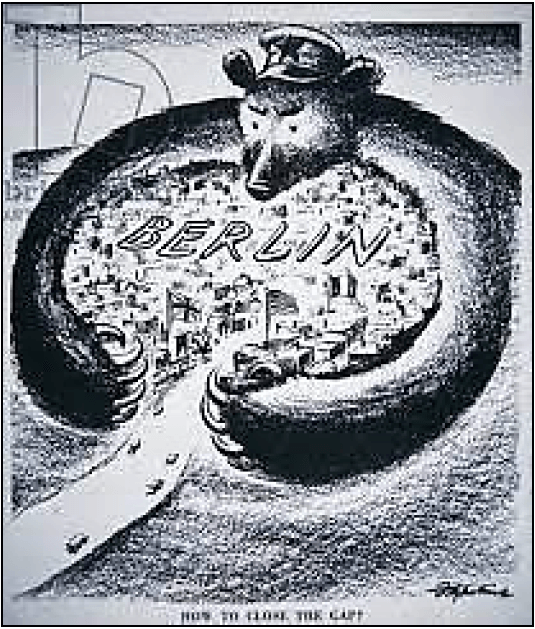
[https://fineartamerica.com/featured/cold-war-berlin-d-r-fitzpatrick.html. Accessed on 25 May 2021.]
QUESTION 2: WHY DID FOREIGN POWERS BECOME INVOLVED IN THE ANGOLAN WAR OF INDEPENDENCE?
SOURCE 2A
This source explains the power struggles that erupted after Angola became independent in 1974.
Three main military movements had been fighting for Angolan independence since the 1960s. The Popular movement for the Liberation of Angola (MPLA) was a Marxist organisation centred in the capital, Luanda, and led by Agostinho Neto. The National Front for the Liberation of Angola (FNLA) led by Holden Roberto, was based in the north of the country and had strong ties to the US ally (friend), Mobutu Sese Seko, in neighbouring Zaire. The National Union for the Total Independence of Angola (UNITA), an offshoot of the FNLA, was led by Jonas Savimbi and supported by the country’s largest ethnic group, the Ovimbundu. [From https://history.state.gov/milestones/1969-1976/angola. Accessed on 26 May 2021.] |
SOURCE 2B
The source below outlines the reasons for South Africa’s involvement in Angola during the 1970s.
SA’s first intervention of Angola seems to have resulted from the need to secure and protect its own interests. The government was severely anti-communist at this time, as the notion of the ‘total national strategy’ against the ‘total onslaught’ of communism became the all-encompassing factor that determined foreign policy. SA’s détente politics toward Africa at this time was pursued rather successfully prior to the Angolan intervention in order to establish buffer zones, which would hopefully protect SA from the increasing communist threat. In addition, SA was becoming increasingly worried about this possible threat as the USSR and Cuba were enlarging their support to the MPLA after the coup in Portugal in 1974. The concentration of SWAPO insurgents on the southern Angola border furthermore endangered SA’s interests in SWA, as SWAPO was one of the MPLA’s biggest African allies. Both the MPLA and SWAPO were seen as Soviet proxies during the Cold War. In addition, SA was pressured by some in the international community to get involved in Angola for the first time. The USA, like SA, was also strongly anti-communist and supported SA’s initial involvement to some extent. France also had concerns. SA also saw its limited initial involvement as an opportunity to establish a less hostile government in Angola, than what was already established in Mozambique. The FNLA, UNITA and several African and international actors such as Zaire and even Zambia made similar requests. South Africa decided that it would be in its own as well as the region’s best interest to intervene in the Angolan conflict. [From South Africa’s Intervention in Angola: Before Cuito Cuanavale and Thereafter file:///E:/Angola%202/labuschagne_south_2009.pdf. Accessed on 26 May 2021.] |
SOURCE 2C
The extract below indicates how the United States of America supported UNITA during the Angolan Civil War.
The Central Intelligence Agency (CIA) made its first major weapons shipment to the FNLA in July 1975. Thus, like the Russians and Chinese, the United States was giving aid to one side of Angolan Civil War on a level far greater than it had ever provided during the struggle against Portuguese colonialism. The United States was directly involved in the civil war to a marked (noticeable) degree. In addition to training Angolan combat units, US personnel did considerable flying between Zaire and Congo carrying out reconnaissance (investigation) and supply missions, and the CIA spent over a million dollars on an ambitious mercenary (hired soldiers) programme. Several reports appeared in the US press stating that many American guerrillas were fighting in Angola against the MPLA from ‘scores’ to ‘300’ and that many others were recruited and trained in the United States to join them. But John Stockwell, the head of CIA’s Angola task force, puts the number of American mercenaries who actually made it to Angola at only 24. The CIA was also directly financing the arming of British mercenaries (fighting in Angola). Subsequently (later) the Secretary of the State, Henry Kissinger, informed the Senate that ‘the CIA is not involved’ in the recruitment of mercenaries for Angola. … Through recruited journalists representing major news service, the Agency (CIA) was able to generate international coverage of false reports for Soviet advisers in Angola. One CIA story, announced to the press by UNITA, was that 20 Russians and 35 Cubans had been captured. Another fabrication (lie) concerned alleged rapes committed by Cuban soldiers in Angola; this was elaborated to include their capture, trial and execution … From http://williamblum.org/chapters/killing-hope/angola. Accessed on 7 March 2020.] |
SOURCE 2D
This poster depicts President Agostinho Neto and Fidel Castro after Angolan independence celebrations.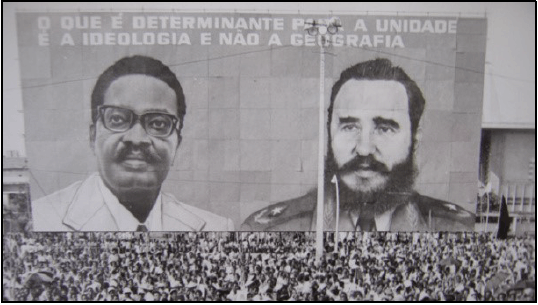
[From https://mrdivis.wordpress.com/2016/12/02/remembering-fidel-castros-impact-in-southern-africa/. Accessed on 20 May 2021.]
QUESTION 3: HOW DID THE PROCESS OF SCHOOL INTEGRATION UNFOLD AT CENTRAL HIGH SCHOOL IN LITTLE ROCK, ARKANSAS?
SOURCE 3A
This extract focuses on Daisy Bates’ struggle to bring an end to school segregation in Little Rock.
Faubus’ alleged reason for calling out the troops was that he had received information that caravans of automobiles filled with white supremacists were heading toward Little Rock from all over the state. He therefore declared Central High School off limits to Negroes. He delivered the infamous words, ‘blood will run in the streets’ if Negro pupils should attempt to enter Central High School and with these words he made his contribution to the mass hysteria that was to grip the city of Little Rock for several months. The citizens of Little Rock gathered on 3 September to gaze upon the incredible spectacle of an empty school building surrounded by 250 armed National Guard troops. At about eight fifteen in the morning, Central High students started passing through the line of National Guardsmen – all but the nine Negro students. I had been in touch with their parents throughout the day. They were confused, and they were frightened. As the parents voiced their fears, they kept repeating Governor Faubus’ words that ‘blood would run in the streets of Little Rock’ should their teenage children try to attend Central – the school to which they had been assigned by the School Board. [From http://-spartacus-educational.com/USAlittlerock.htm?menu=USAevents3. Accessed on 31 May 2021.] |
SOURCE 3B
The following is an interview with Elizabeth Eckford, one of the nine African American students who was enrolled at Central High School in 1957.
The night before the Governor had gone on television and announced that he had called out the Arkansas National Guard, I thought he had done this to ensure the protection of all students. We did not have a telephone. So inevitably I was not contacted to let me know that Daisy Bates of the NAACP had arranged for some ministers to accompany the (nine black) students in a group. And so it was that I arrived alone … At the corner I tried to pass through the long line of guards around the school so as to enter the grounds behind them. One of the guards pointed across the street. So, I pointed in the same direction and asked whether he meant for me to cross the street and walk down. He nodded ‘yes’. So, I walked across the street, conscious of the crowd that stood there, but they moved away from me. For a moment all I could hear was the shuffling of the feet. Then someone shouted, ‘Here she comes, get ready!’ I moved away from the crowd on the sidewalk and into the street. If the mob came at me, I could then cross back over so the guards could protect me. The crowd moved in closer and then began to follow me, calling me names. I still wasn’t afraid, just a little bit nervous. All the time I kept thinking that the guards would protect me. When I got in front of the school, I went up to a guard again. But this time he just looked straight ahead and didn’t move to let me pass him. When I tried to squeeze past him, he raised his bayonet and then the guards moved in and they raised their bayonets. I turned around and the crowd came toward me. Somebody started yelling, ‘Lynch her! Lynch her!’ I tried to see a friendly face somewhere in the mob-scene who maybe would help. I looked into the face of an old woman and it seemed a kind face, but when I looked at her again, she spat on me. [From http://spartacus-educational.com/USAlittlerock.htm?menu=USAevents3. Accessed on 31 May 2021.] |
SOURCE 3C
This photograph shows a young white woman, Hazel Bryan, shouting at Elizabeth Eckford while attempting to enter the Central High School yard.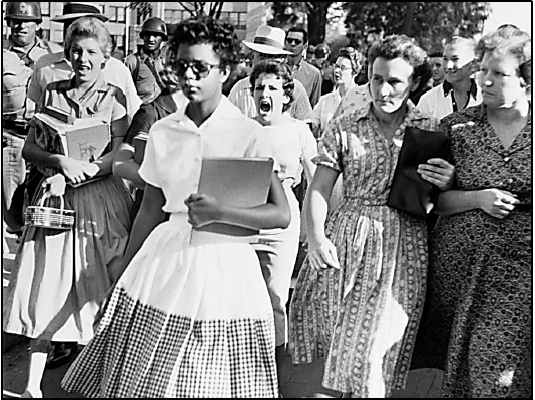
[From www.gettyimages.com/photos/elizabeth-eckford. Accessed on 3 June 2021.]
SOURCE 3D
The following extract focuses on the reaction of fellow students to school integration
Three young girls, barely into their teens, fell in directly behind Elizabeth. They were clearly together, and clearly students, two of them, like Elizabeth, carried books. They wanted to get close to Elizabeth, close enough to let her know that they didn’t want her in their school. It was easy, everyone, the television reporters, the grown-ups in the vacant lot across the street, the other kids were either egging (encouraging) them on, or, like the soldiers and policemen, paying them no mind. No one was telling them not to do anything. ‘Two, four, six, eight! We don’t want to integrate!’ they chanted. The girl to Elizabeth’s right, Hazel Bryan, looked livid (furious), her face poisoned with hate. As Benjamin Fine of the New York Times later described her, ‘she was screaming, just hysterical, just like one of these Elvis Presley hysterical deals, where these kids are fainting with hysteria’. Her eyes narrowed, her brow furrowed, her teeth clenched (tightened) as if about to bite. Hazel then shouted some more: ‘Go home, nigger! Go back to Africa!’ A photographer captured Hazel Bryan shouting these words at Elizabeth Eckford and published the photograph on the front page of a local publication called the Gazette. [From Elizabeth and Hazel – Two of Little Rock by D Margolick] |
ACKNOWLEDGEMENTS
Visual sources and other historical evidence were taken from the following:
- http://www.historytoday.com/david-williamson/berli-flash-point-cold-war-1948-1989
- http://www.coldwar.org/article/40s/berlin-blockade.asp
- http://history.state.gov/milestones/1945-1952/berlin.airlift
- https://fineartamerica.com/featured/cold-war-berlin-d-r-fitzpatrick.html
- http://spartacus-educational.com/USAlittlerock.htm?menu=USAevents3.
- Elizabeth and Hazel – Two Women of little Rock by D Margolick.
- www.gettyimages.com/photos/elizabeth-eckford
- Journal of Cold War Studies. Summer 2013, Vol. 15 Issue 3, p4–33. 30p
- Mazrui, A. 1993. General History of Africa, Vol. VIII: Africa Since 1935 (Heinemann, University of California)
- Waters, M.A. 2013. Cuba & Angola – Fighting for Africa's Freedom and Our Own (Pathfinder Press, Johannesburg)
- https://spartacus-educational.com/USAhamptonF.htm
Geography Paper 1 Topographical and Orthophoto Map of Caledon - Grade 12 June 2021 Exemplars
MAP OF CALEDON
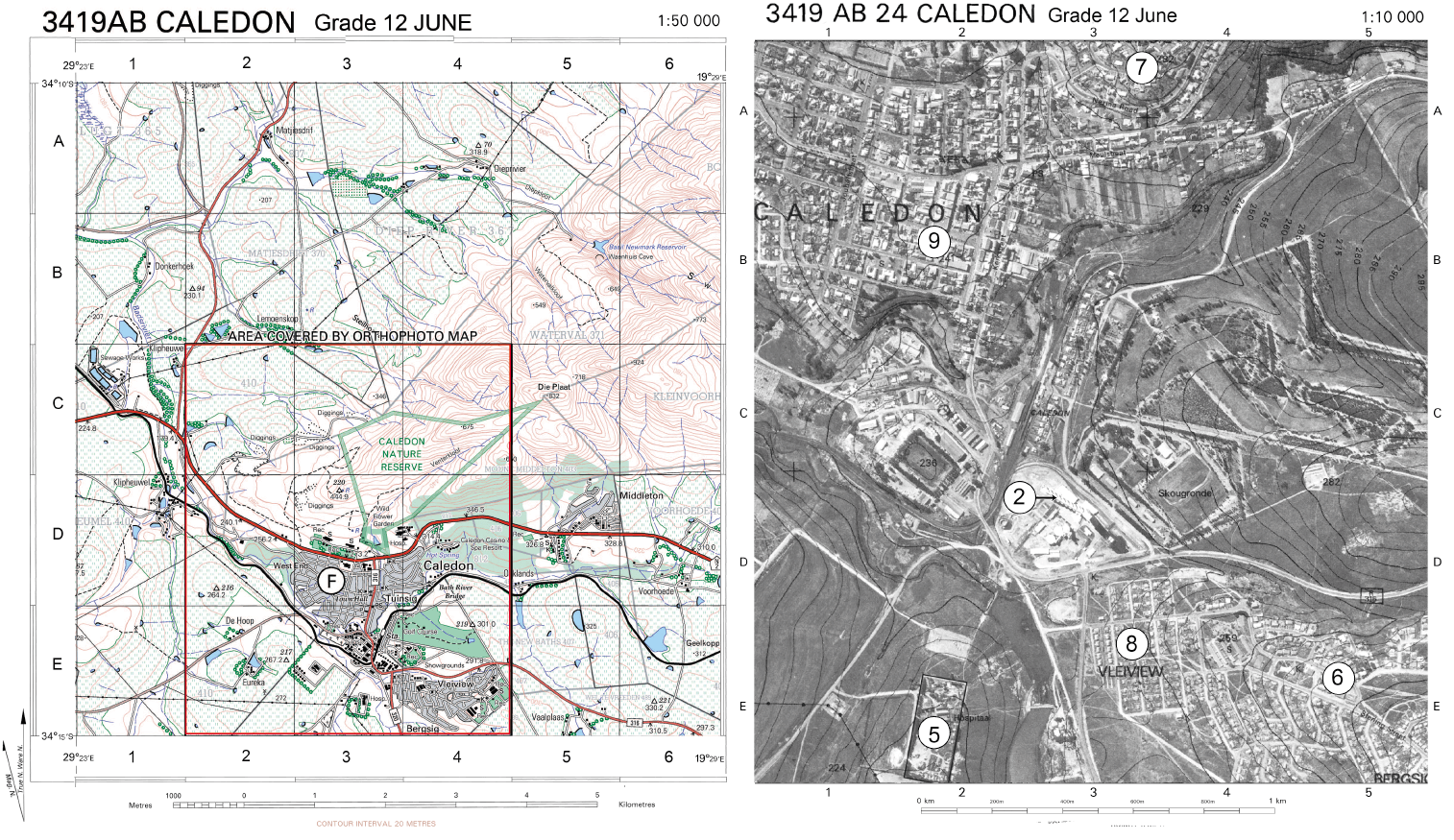

Geography Paper 1 Memorandum - Grade 12 June 2021 Exemplars
MEMORANDUM
SECTION A
QUESTION 1: WEATHER AND CLIMATE
1.1
1.1.1 Cumulonimbus (1)
1.1.2 southern
1.1.3 easterly (1)
1.1.4 Clear skies (1)
1.1.5 outside (1) (5 x 1) (5)
1.2
1.2.1 Isotherms (1)
1.2.2 12 ⁰C (1)
1.2.3 rural areas (1)
1.2.4 CBD (1)
1.2.5 A to B (1) (5 x 1) (5)
1.3
1.3.1 Air pressure (1) (1 x 1) (1)
1.3.2
- South Atlantic high further north indicating the northward migration of the ITCZ (1)
- South Indian high further from the land (1) Clear skies over the interior (1)
- Kalahari high dominant over the interior (1)
(Any ONE) (1 x 1) (1)
1.3.3 Descending air is stronger than the convection stream during winter (2) The inversion layer will be pushed towards/beyond the plateau (2) (2 x 2) (4)
1.3.4
- West to east/Easterly/eastwards (1) (1 x 1) (1)

(4 x 1) (4)- Clockwise movement of air around a low pressure is causing south-westerly winds at D and north-westerly winds at E (2) Onshore winds experienced at D and offshore winds at E (2) (2 x 2) (4)
1.4
1.4.1 Meeting of warm, moist air and cold, dry air over the interior of South Africa (2) (CONCEPT) (1 x 2) (2)
1.4.2 Summer (1) (1 x 1) (1)
1.4.3
- Anti-clockwise movement of air from pressure system A causes cold, dry air to move towards the interior of South Africa (2)
- Anti-clockwise movement of air from pressure system B causes warm, moist air to move towards the interior of South Africa (2)
- The cold, dry air meets the warm, moist air over the interior forming the moisture front (2)
(Any TWO) (2 x 2) (4)
1.4.4 Negative impact
- Cumulonimbus clouds cause heavy rainfall and flooding will destroy infrastructure (2)
- Heavy rainfall will cause soil erosion, which makes soil infertile and affects crop production (2)
- Productivity decreases due to strong winds (2) Lightning may cause crops to catch fire (2)
- Fields can become waterlogged after torrential/heavy rain, which decreases crop production (2)
- Strong and gusty winds destroy crop plantations and infrastructure (2)
Positive impact
- Rains will fill dams, which increases water availability through irrigation (2)
- Long term effects of floods will make the soil fertile (2) Productivity will increase (2)
(Any FOUR) (4 x 2) (8)
[40]
QUESTION 2: GEOMORPHOLOGY
2.1
2.1.1 dendritic (1)
2.1.2 acute angles (1)
2.1.3 Uniform (1)
2.1.4 3 (1)
2.1.5 interfluve (1) (5 x 1) (5)
2.2
2.2.1 Laminar (1)
2.2.2 Turbulent (1)
2.2.3 Laminar (1)
2.2.4 Turbulent (1)
2.2.5 Turbulent (1) (5 x 1) (5)
2.3
2.3.1 High lying area between two drainage basins (1) (CONCEPT) (1 x 2) (2)
2.3.2 River A is flowing over softer rock (1) River A is flowing at a lower level (1) (Any ONE) (1 x 1) (1)
2.3.3
- It lowers the watershed (1)
- It causes a gap in the watershed (1) (Any ONE) (1 x 1) (1)
2.3.4
- Increase in water volume (2) River is longer (2)
- River has more erosive power (2)
- Starts to erode vertically again (2) (Any TWO) (2 x 2) (4)
2.3.5 The valley through which it flows is too big (2) Stream has too little water (2) (Any ONE) (1 x 2) (2)
2.3.6
- Elbow of capture (1) (1 x 1) (1)
- Tourist attraction because of the knickpoint waterfall (2)
Due to falling water, hydro-electricity can be generated (2) (2 x 2) (4)
2.4
2.4.1 Permanent/Perennial (1) (1 x 1) (1)
2.4.2
- Upper level of the groundwater, where soil and rocks are permanently saturated with water (1) (CONCEPT) (1 x 2) (2)
- In sketch A the water table is higher than in sketch B (2) (1 x 2) (2)
- Continuous pumping of water from the well, will lower the water table (2)
The well makes the ground less saturated and decreases flooding/overflow of the river (2)
(Any ONE) (1 x 2) (2)
2.4.3
- More soil erosion will cause more silt deposits in the river, thus decreasing water capacity (2)
- Silting of the river might cause it to become non perennial (2)
- Less infiltration will lower the water table, with a decrease in groundwater flow hence decreasing the volume of water (2)
- Less evapo-transpiration will decrease rainfall, which will affect the volume of water in the long term (2) (4 x 2) (8)
[40]
QUESTION 3: RURAL AND URBAN SETTLEMENTS
3.1
3.1.1 F (1)
3.1.2 C (1)
3.1.3 D (1)
3.1.4 E (1)
3.1.5 A (1) (5 x 1) (5)
3.2
3.2.1 Threshold population (1)
3.2.2 Invasion (1)
3.2.3 Urban hierarchy (1)
3.2.4 Urban sprawl (1)
3.2.5 Urban profile (1) (5 x 1) (5)
3.3
3.3.1 The manner in which farms and houses are arranged (1) (CONCEPT) (1 x 2) (2)
3.3.2 Nucleated (1) (1 x 1) (1)
3.3.3
- Flat land made it easier to expand (2)
- Fertile soil allows farmers to stay together with enough land surrounding them to farm (2) (2 x 2) (4)
3.3.4
- T-shape (1) (1 x 1) (1)
- Main roads joining in a T-shape (1) (1 x 1) (1)
- Easy access to most farmland (1)
Easy access to markets (1)
(Any ONE) (1 x 1) (1)
3.3.5
- Land is fragmented, therefore hampering initiative and expansion (2)
- Traveling between cultivated lands have extra financial implications (2)
- Profits might be shared between farmers due to communal ownership (2)
(Any TWO) (2 x 2) (4)
3.4
3.4.1 The physical growth of the urban area (2) (CONCEPT) (1 x 2) (2)
3.4.2 An increase in the number of people in urban areas will necessitate the building of more living quarters, the extension of infrastructure and the construction of more industries (2) (1 x 2) (2)
3.4.3
- Fertile soil is being removed (2)
- Natural habitats of species are being removed (2)
- Biodiversity and ecosystems are being disturbed (2)
- Increase of the heat island effect due to artificial production of heat (2)
(Any TWO) (2 x 2) (4)
3.4.4
- Infrastructure needs constant maintenance (2)
- Industrial development creates more job opportunities (2)
- Better infrastructure attracts investment with more employment opportunities (2)
- Construction of new buildings creates more job opportunities (2)
- Upskilling of people creates more job opportunities (2)
Not positive
- Unskilled people will struggle to find jobs (2)
- Expansion into the rural urban fringe will leave people living there with no livelihood (2)
(Any FOUR) (4 x 2) (8)
[40]
SECTION B
QUESTION 4: CALCULATIONS AND MAP SKILLS
4.1
4.1.1
- Formula: Gradient = Vertical Interval (V.I.)
Horizontal Equivalent (H.E.) - Gradient = ( 346,5 – 328,8) m range (1950 – 2050) m
(4(1) cm x 500) m - Gradient = 17,7(1)
2000(1) - Gradient = 17,7
2000 - Gradient = 17,7 : 2000 (1)
17,7 17,7 - Gradient= 1 : 112,9 OR 1 : 113 (1) (Range: 1 : 110 – 1 : 115,8) (5 x 1) (5)
4.2
4.2.1 C (1) (1 x 1) (1)
4.2.2 D (1) (1 x 1) (1)
4.2.3
- 3 cm x 1,3 cm
(3 x 100) x (1,3 x 100)
300(1) m x 130(1) m
Area: 39 000 m² (1) (3 x 1) (3)
4.3
4.3.1
- Mediterranean (1)
- Caledon is in the Western Cape (2)
- Latitude 34° S (2) (western part of South Africa)
(Any ONE) (1 + 2) (3)
4.4
4.4.1 B (1) (1 x 1) (1)
4.4.2 Most rivers are seasonal, and they are in contact with the water-table only in the rainy season (2) (1 x 2) (2)
4.5 4.5.1 Dendritic (1) (1 x 1) (1)
4.5.2 The rivers flow in the V-shaped valleys (2) The rivers flow over a uniform steep slope (2) (Any ONE) (1 x 2) (2)
4.5.3 North Westerly/NNW direction (1) (1 x 1) (1)
4.5.4 Dam wall (Basil Newman Reservoir) is in the northwest (2) Tributaries join the main river downstream in the NW/NNW (2) Generally, contour lines bend towards NW/NNW direction (2)
(Any ONE) (1 x 2) (2)
4.6
4.6.1 D (1) (1 x 1) (1)
4.7 4.7.1 Raster (1) (1 x 1) (1)
4.7.2 Captured images/objects are represented in pixels (2) (1 x 2) (2)
4.7.3
- The use of vector data on a topographic map makes map interpretation more user friendly (2)
- It is easier to obtain data at a glance/quick referencing (2) It makes it easier for data layering (2)
- Data can be rendered at any scale, as symbols are not drawn to scale (2)
- Zooming in and out does not change the quality of the topographic data representation (2)
(Any TWO) (2 x 2) (4)
[30]
TOTAL: 150
Geography Paper 1 Annexure - Grade 12 June 2021 Exemplars
ANNEXURE
FIGURE 1.1: TROPICAL CYCLONES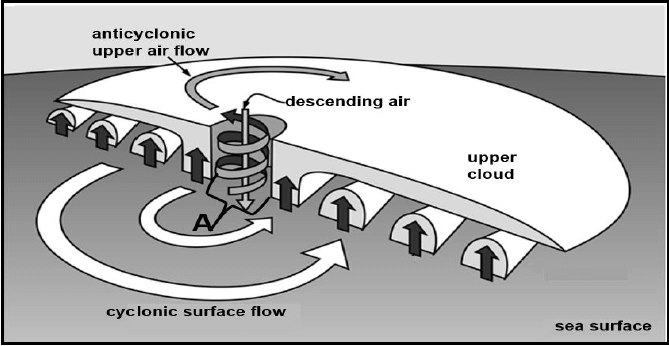
[Source: https://www.google.com/search?q=tropical+cyclone]
FIGURE 1.2: URBAN HEART ISLAND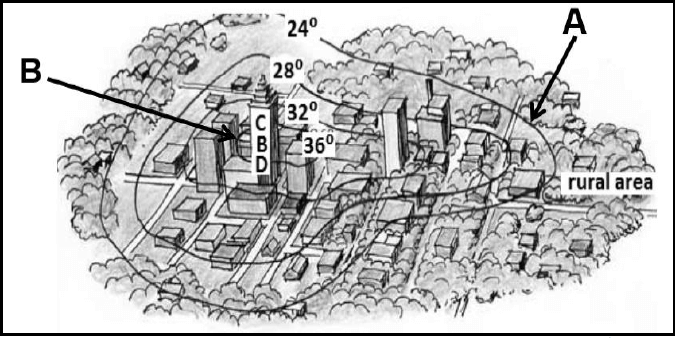
[Source: GSCE Examination series]
FIGURE 1.3: SYNOPTIC WEATHER MAP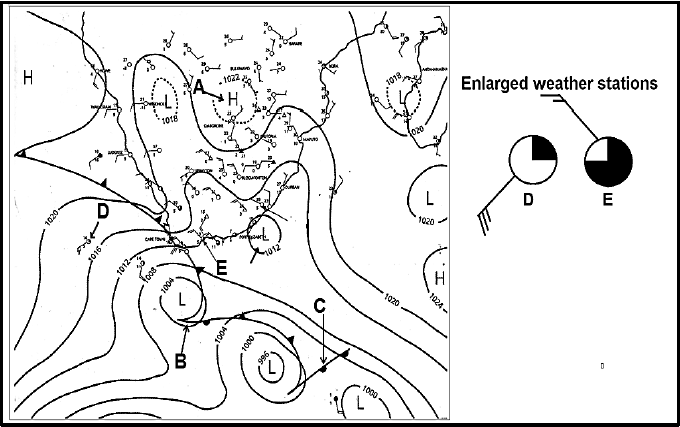
[Adapted from SA weather services
FIGURE 1.4: MOISTURE FRONT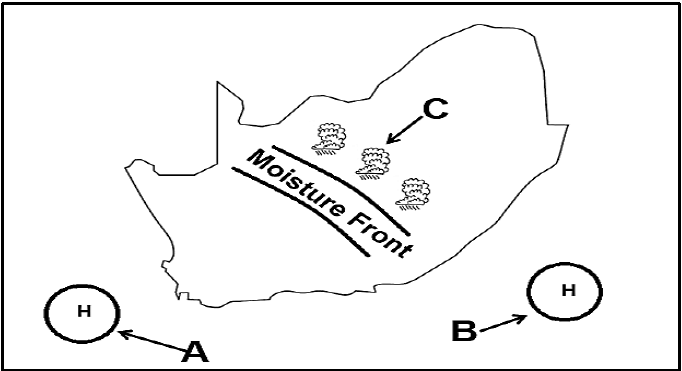
[Source: Examiners own sketch]
FIGURE 2.1: DRAINAGE BASIN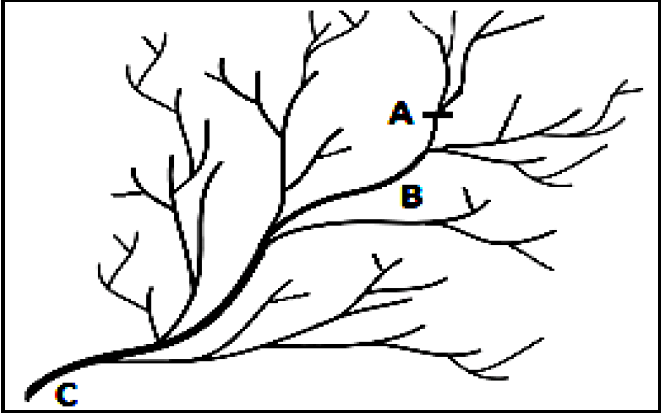
[Source: sageography.myschoolstuff.co.za]
FIGURE 2.2: LAMINAR AND TURBULENT FLOW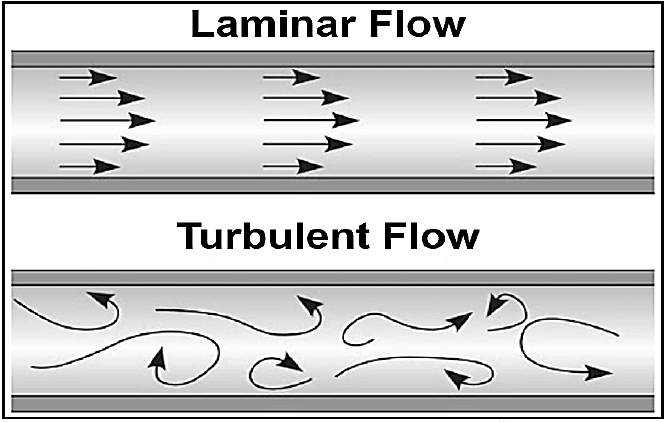
[Source: http://www.Google images]
FIGURE 2.3: RIVER CAPTURE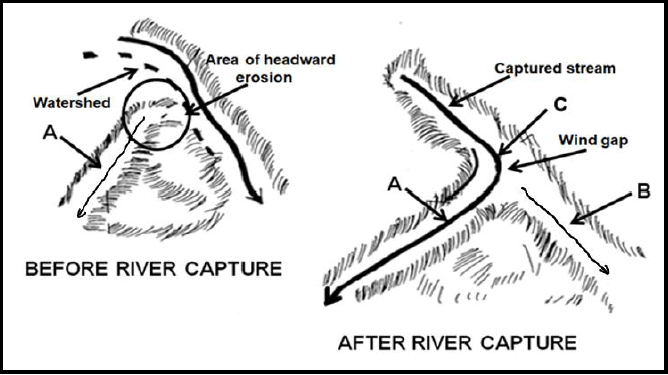
[Adapted from https://www.google.com/search?q=river+capture]
FIGURE 2.4: TYPE OF RIVER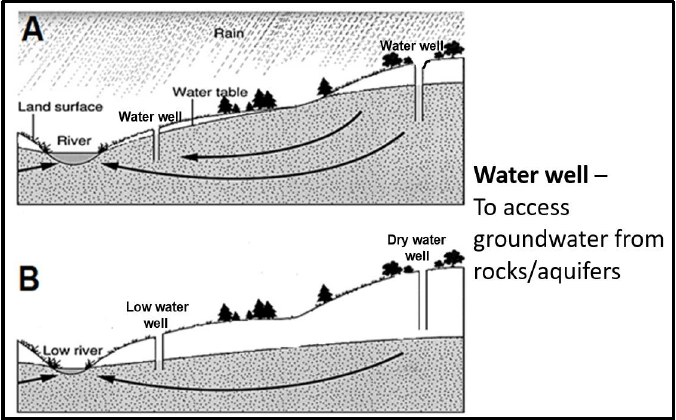
[Adapted from http://www.google search.co.za]
FIGURE 3.3: RURAL SETTLEMENT PATTERN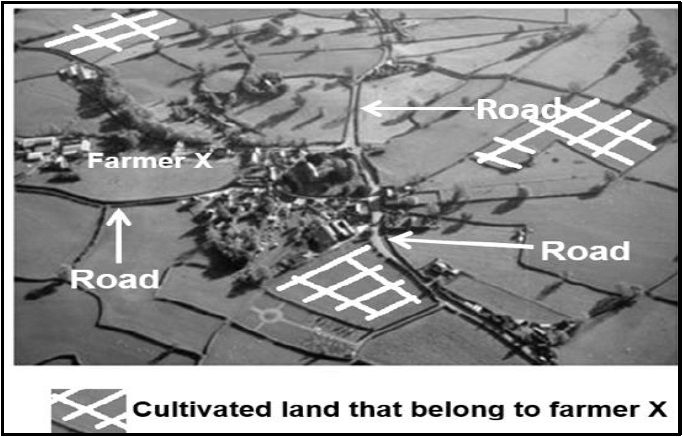
[Adapted from https://www.google.co.za/search?q=Settlement+patterns&source]
FIGURE 3.4: URBAN EXPANSION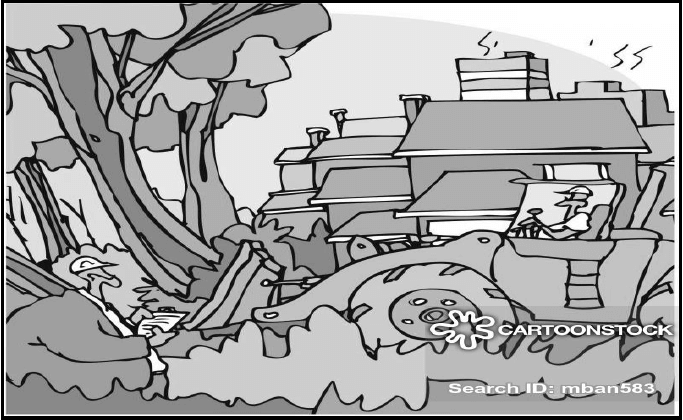
[Source: https://www.google.com/cartoon+on+urban+expansion]
GENERAL INFORMATION ON CALEDON
Caledon has a mediterranean climate of warm, dry summers and cool, wet winters. Temperatures are modified by its close proximity to the South Atlantic Ocean, just over the Klein River Mountains to the south.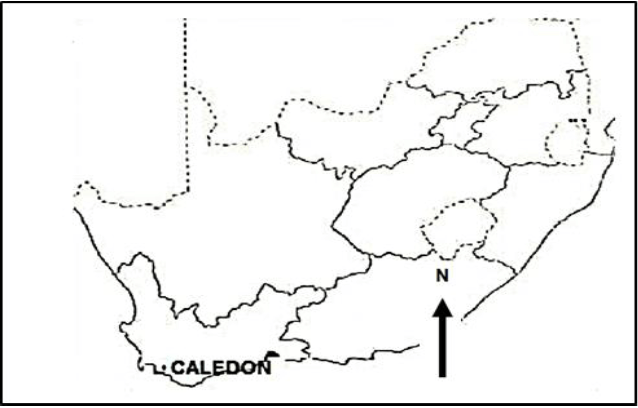
[Source: Examiner’s own extract]
Geography Paper 1 Questions - Grade 12 June 2021 Exemplars
INSTRUCTIONS AND INFORMATION
- This question paper consists of FOUR questions.
- All questions are COMPULSORY.
- All diagrams and maps are included in the ANNEXURE.
- Number the questions correctly according to the numbering system used in this question paper.
- Leave a line between subsections of questions answered.
- Start EACH question on a NEW page.
- Do NOT write in the margins of the ANSWER BOOK.
- Illustrate your answers with labelled diagrams, where possible.
- Mark allocation is as follows: (2 x 1) = (2) means that TWO facts are required for ONE mark each (2 x 2) = (4) means that TWO facts are required for TWO marks each
- If words/action verbs like Name, Identify, Provide, Classify, are used in a question, ONE-word answers are acceptable.
If words/action verbs like Discuss, Define, Explain, Comment, Evaluate, Justify, Suggest and Substantiate are used in a question, FULL sentences or phrases are required.
All paragraph questions must be answered in FULL sentences. - In SECTION B you are provided with a 1: 50 000 topographical map (3419 AB CALEDON) and an orthophoto map (3419AB 24 CALEDON) of a part of the mapped area.
- Show ALL calculations. Marks will be allocated for these.
- Indicate the unit of measurement in the final answer of calculations, for example 10 km, 4°C.
- You may use a non-programmable calculator and a magnifying glass.
- The area demarcated in RED/BLACK on the topographical map represents the area covered by the orthophoto map.
- Write neatly and legibly.
QUESTIONS
SECTION A
QUESTION 1: WEATHER AND CLIMATOLOGY
1.1 FIGURE 1.1 illustrate the development and weather characteristics of a tropical cyclone. Choose the correct concept/term from those given between brackets to make the statements TRUE. Write only the word(s) next to the question number (1.1.1–1.1.5) in the ANSWER BOOK.
1.1.1 (Stratus/Cumulonimbus) clouds forms part of the upper cloud in the sketch.
1.1.2 This tropical cyclone developed in the (southern/northern) hemisphere.
1.1.3 The (easterly/westerly) global wind belt causes tropical cyclones to generally move in a westerly direction.
1.1.4 (Heavy rainfall/Clear skies) dominate the area at A.
1.1.5 This tropical cyclone will develop (inside/outside) 5° north and south latitudes. (5 x 1) (5)
1.2 FIGURE 1.2 shows an urban heat island. Choose the correct word(s)/ numbers from those given between brackets. Write only the word(s)/numbers next to the question number (1.2.1–1.2.5) in the ANSWER BOOK.
1.2.1 Lines representing temperature are called (isohyets/isotherms).
1.2.2 The difference in temperature between A and B is (10°C/12°C).
1.2.3 Evaporation rates are higher in the (CBD/rural area).
1.2.4 Frequency of rainfall is more in the (CBD/rural area).
1.2.5 The general flow of air during the day will be from (A to B/B to A). (5 x 1) (5)
1.3 FIGURE 1.3 is a synoptic weather map.
1.3.1 What do isobars represent on a synoptic weather map? (1 x 1) (1)
1.3.2 FIGURE 1.3, illustrates typical winter conditions. Give ONE reason evident on the map to substantiate this statement. (1 x 1) (1)
1.3.3 Explain the influence of high-pressure cell A on the position of the inversion layer in winter. (2 x 2) (4)
1.3.4 Refer to the mid-latitude cyclone B.
- In which direction does this mid-latitude cyclone move? (1 x 1) (1)
- Sketch a cross profile of front C. Indicate the following on the cross profile:
- Type of clouds
- Gradient of the front
- Warm and cold air masses (4 x 1) (4)
- Why is there a difference in wind direction between weather stations D and E? (2 x 2) (4)
1.4 FIGURE 1.4 shows the development of a moisture front.
1.4.1 What is a moisture front? (1 x 2) (2)
1.4.2 In which season does a moisture front mainly develop? (1 x 1) (1)
1.4.3 How does pressure systems A and B influence the development of the moisture front? (2 x 2) (4)
1.4.4 In a paragraph of approximately EIGHT lines, explain how the weather from cloud type C, will impact farming in the interior of South Africa. (4 x 2) (8)
[40]
QUESTION 2: GEOMORPHOLOGY
2.1 FIGURE 2.1 shows a drainage basin. Choose the correct concept/term/ number from those given between brackets to make the statements TRUE. Write only the concept/term/number next to the question number (2.1.1–2.1.5) in the ANSWER BOOK.
2.1.1 This drainage pattern is known as (trellis/dendritic).
2.1.2 The tributaries in the drainage basin join the mainstream at (right angles/acute angles).
2.1.3 (Uniform/Varied) resistance to erosion is a characteristic of the underlying rock structure of this drainage pattern.
2.1.4 The stream order at A is (2/3).
2.1.5 A/An (interfluve /watershed) can be found at B. (5 x 1) (5)
2.2 Refer to FIGURE 2.2 and write only the correct type of flow (laminar or turbulent) next to the statement number (2.2.1–2.2.5) below.
2.2.1 This type of flow generally dominates the lower course of a river
2.2.2 Erosion is the main geomorphological process
2.2.3 This type of flow will promote the development of floodplains
2.2.4 This type of flow usually occurs in the upper course of the river
2.2.5 The outer bank of a river experiences this type of flow (5 x 1) (5)
2.3 FIGURE 2.3 shows the process of river capture.
2.3.1 What is a watershed? (1 x 2) (2)
2.3.2 Name ONE condition that would promote headward erosion. (1 x 1) (1)
2.3.3 What influence will headward erosion have on the watershed? (1 x 1) (1)
2.3.4 Discuss TWO natural (physical) changes that river A experienced after river capture. (2 x 2) (4)
2.3.5 Why is the river at B known as a misfit stream? (1 x 2) (2)
2.3.6 Refer to the feature labelled C.
- Give the name of feature C. (1 x 1) (1)
- Explain TWO economic advantages of feature C. (2 x 2) (4)
2.4 Study FIGURE 2.4. which illustrates a type of river during different seasons.
2.4.1 Name the type of river evident in the sketches A and B. (1 x 1) (1)
2.4.2 Refer to the water table in both sketches.
- Define a water table. (1 x 2) (2)
- Differentiate between the water table in cross profiles A and B. (1 x 2) (2)
- Describe the impact of the water wells on the water table. (1 x 2) (2)
2.4.3 In paragraph of approximately EIGHT lines, explain the possible impact that deforestation will have on the volume of water in the river. (4 x 2) (8)
[40]
QUESTION 3: RURAL AND URBAN SETTLEMENTS
3.1 Choose a term in COLUMN B that matches the description in COLUMN A. Write only the letter (A–F) next to the question number (3.1.1–3.1.5) in the ANSWER BOOK, for example 3.1.6 G.
COLUMN A | COLUMN B | ||
3.1.1 | The natural piece of land on which a settlement can be found | A | wet point settlement |
3.1.2 | Refers to the settlement in relation to its surrounding environment | B | unifunctional |
3.1.3 | Settlement located away from the danger of water | C | situation |
3.1.4 | Secondary and tertiary activities dominate in this type of settlement | D | dry point settlement |
3.1.5 | Settlement in dry areas located near the water source | E | multifunctional |
F | site | ||
(5 x 1) (5)
3.2 Match the term/concepts below to the statements that follow. Write ONLY the term/concept next to the question number, e.g, 3.2.6 South Africa.
urban hierarchy; break-of-bulk point; threshold population; urban profile; Invasion; urban sprawl |
3.2.1 Minimum number of people needed to make a business profitable
3.2.2 Replacement of the original type of land use with another
3.2.3 Ranking of urban settlements according to function
3.2.4 The shapeless uncontrolled expansion of the city
3.2.5 Shows the height of the buildings in the city (5 x 1) (5)
3.3 FIGURE 3.3 depicts a rural settlement pattern.
3.3.1 Define the concept settlement pattern. (1 x 2) (2)
3.3.2 Name the settlement pattern depicted by FIGURE 3.3. (1 x 1) (1)
3.3.3 Explain TWO physical (natural) factors that influenced the pattern of this settlement. (2 x 2) (4)
3.3.4 Refer to the shape of the settlement.
- Identify the shape of this settlement. (1 x 1) (1)
- Name the main factor that has influenced the shape of the settlement. (1 x 1) (1)
- Comment on ONE advantage of this shape for the community. (1 x 1) (1)
3.3.5 Explain TWO economic disadvantages for farmer X. (2 x 2) (4)
3.4 FIGURE 3.4 is a cartoon based on the process of urban expansion.
3.4.1 Define the concept urban expansion. (1 x 2) (2)
3.4.2 Explain why urban expansion is not possible without urban growth. (1 x 2) (2)
3.4.3 Comment on the environmental injustice caused by urban expansion in FIGURE 3.4. (2 x 2) (4)
3.4.4 In a paragraph of approximately EIGHT lines, evaluate the positive impact of urban expansion on job creation. (4 x 2) (8)
[40]
TOTAL SECTION A: 120
SECTION B: MAPWORK APPLICATION
QUESTION 4: CALCULATIONS AND MAP SKILLS
4.1 Refer to blocks D4 and D5 on the topographical map.
4.1.1 Calculate the average gradient of the N2 road between bench marks 346,5 (block D4) and 328,8 (block D5) on the topographical map. The answer must be written as a RATIO.
Show ALL calculations. Marks will be awarded for calculations. (5 x 1) (5)
Formula: Gradient = Vertical Interval (V.I)
Horizontal Equivalent (H.E)
4.2 Various options are provided as possible answers to QUESTIONS 4.2.1 and
4.2.2. Choose the correct answer and write only the letter (A–D) next to the question number.
4.2.1 The length (L) of the hospital (area 5) on the orthophoto map is … centimetres (cm).
- 30
- 13
- 3
- 1,4 (1 x 1) (1)
4.2.2 The breadth (B) of the hospital (area 5) on the orthophoto map is… centimetres (cm).
- 0,3
- 13
- 3,3
- 1,3 (1 x 1) (1)
4.2.3 Using the answers to QUESTIONS 4.2.1 and 4.2.2, calculate the area of the hospital 5 in square meters (m²). Show ALL calculations. Marks will be awarded for calculations.
Formula: Area = length (L) x breadth (B) (3 x 1) (3)
MAP INTERPRETATION
4.3 Refer to the topographical and orthophoto maps.
4.3.1 What type of climate does Caledon experience? Give a reason for your answer. (1 + 2) (3)
4.4 Rainfall in the mapped area is seasonal.
4.4.1 Which one of the cross sections A or B would represent the rivers in block D1?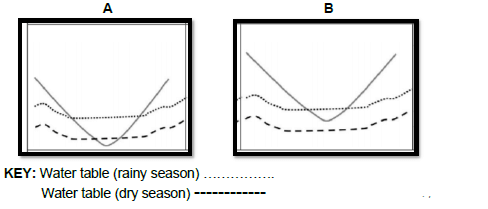
(1 x 1) (1)
4.4.2 Explain your answer to QUESTION 4.4.1. (1 x 2) (2)
4.5 Refer to the block B5 on the topographical map.
4.5.1 Identify the dominant drainage pattern of the rivers in block B5 on the topographical map. (1 x 1) (1)
4.5.2 Provide ONE map evidence to explain why the drainage pattern identified in QUESTION 4.5.1 developed. (1 x 2) (2)
4.5.3 In which general direction are the rivers in block B5 flowing? (1 x 1) (1)
4.5.4 Give ONE map evidence to support the answer to QUESTION 4.5.3. (1 x 2) (2)
GEOGRAPHICAL INFORMATION SYSTEMS (GIS)
4.6 Various options are provided as possible answers to the following question. Choose the correct answer and write only the letter (A–D) next to the question number (4.6.1) in your ANSWER BOOK.
4.6.1 A map designed to show a single spatial distribution pattern, using a specific map type, is known as a …
- topographical map.
- orthophoto map.
- world map.
- thematic map. (1 x 1) (1)
4.7 Spatial data is stored in two different formats, namely vector and raster data.
4.7.1 Is the orthophoto map of Caledon, vector or raster? (1 x 1) (1)
4.7.2 Give ONE reason for your answer to QUESTION 4.7.1 (1 x 2) (2)
4.7.3 Explain TWO reason why GIS specialists prefer using vector data
on topographical maps to raster data. (2 x 2) (4)
[30]
TOTAL SECTION B: 30
GRANDTOTAL: 150
Life Sciences Memorandum - Grade 12 June 2021 Exemplars
PRINCIPLES RELATED TO MARKING LIFE SCIENCES
- If more information than marks allocated is given.
Stop marking when maximum mark is reached and put a wavy line and ‘max’ in the right-hand margin. - If, for example, three reasons are required and five are given.
Mark the first three irrespective of whether all or some are correct/ incorrect. - If whole process is given when only a part of it is required. Read all and credit the relevant part.
- If comparisons are asked for, and descriptions are given. Accept if the differences/similarities are clear.
- If tabulation is required but paragraphs are given. Candidates will lose marks for not tabulating.
- If diagrams are given with annotations when descriptions are required. Candidates will lose marks.
- If flow charts are given instead of descriptions. Candidates will lose marks.
- If sequence is muddled and links do not make sense.
Where sequence and links are correct, credit. Where sequence and links are incorrect, do not credit. If sequence and links become correct again, resume credit. - Non-recognised abbreviations.
Accept if first defined in answer. If not defined, do not credit the unrecognised abbreviation, but credit the rest of the answer if correct. - Wrong numbering.
If answer fits into the correct sequence of questions, but the wrong number is given, it is acceptable. - If language used changes the intended meaning. Do not accept.
- Spelling errors.
If recognisable, accept the answer, provided it does not mean something else in Life Sciences or if it is out of context. - If common names are given in terminology.
Accept, provided it was accepted at the national memo discussion meeting. - If only the letter is asked for, but only the name is given (and vice versa).
Do not credit. - If units are not given in measurements.
Candidates will lose marks. Marking guideline will allocate marks for units separately. - Be sensitive to the sense of an answer, which may be stated in a different way.
- Caption
All illustrations (diagrams, graphs, tables, etc.) must have a caption. - Code-switching of official languages (terms and concepts)
A single word or two that appear(s) in any official language other than the learners' assessment language used to the greatest extent in his/her answers should be credited, if it is correct. A marker that is proficient in the relevant official language should be consulted. This is applicable to all official languages.
MEMORANDUM
SECTION A
QUESTION 1
1.1
1.1.1 A √√
1.1.2 D √√
1.1.3 A √√
1.1.4 B √√
1.1.5 C √√
1.1.6 B √√
1.1.7 C √√
1.1.8 C √√
1.1.9 D √√ (9 x 2) (18)
1.2
1.2.1 Blastocyst √
1.2.2 Internal √fertilisation
1.2.3 Peptide √bonds
1.2.4 Umbilical vein √
1.2.5 Gene √
1.2.6 Grommets √
1.2.7 Chromatin network √ (7 x 1) (7)
1.3
1.3.1 B only √√
1.3.2 B only √√
1.3.3 Both A and B √√ (3 x 2) (6)
1.4
1.4.1
- PpLI √√ (2)
- Ppll √√ (1)
1.4.2 25% √√ (2)
1.5
1.5.1
- A √ – Dendrite √(2)
- D √ – Synapse √ (2)
- E √ – Interneuron √/Connector neuron (2)
1.5.2
- B √ (1)
- C √ (1)
1.6
1.6.1
- Prostate gland √ (1)
- Epididymis √ (1)
1.6.2
- G √ – urethra √ (2)
- E √ – testis √ (2)
TOTAL SECTION A: 50
SECTION B
QUESTION 2
2.1
2.1.1
- Nuclear membrane √/(nucleus) (1)
- DNA √ (1)
2.1.2
- Carries the coded message from DNA √ in the nucleus to the ribosomes for protein synthesis (1)
2.1.3 Translation √*
- The anticodon on the tRNA/molecule Z matches the codon on the mRNA √
- tRNA brings the required amino acid √
- to the ribosome √/structure F
- Amino acids are joined by peptide bonds √
- to form the required protein √ (*1 compulsory + 5) (6)
2.1.4
- Adenine √ (1)
- UUU-CAU-GAC-GCG √√ (correct sequence) (2)
- GUA √√ (2)
2.2.1 Prophase I √ (1)
2.2.2
- Crossing over √*
- Chromosomes pair up √/ homologous chromosomes / bivalents form
- Chromosomes overlap √/cross over
- at points called chiasmata √
- Exchange of genetic material occurs between chromatids √ /adjacent chromosome pairs
(*1 compulsory + 4) (5)
2.2.3
- Brings about variation √ in the gametes
- by ensuring that no two gametes are the same √(2)
2.3
2.3.1 Pedigree diagram √/ Genetic lineage (1)
2.3.2
- 1 √ (1)
- 2 √ (1)
2.3.3
- XHXh √ (1)
- XhY √ (1)
2.3.4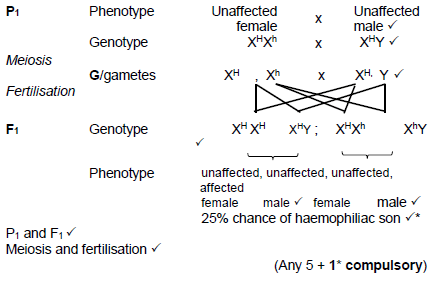
(Any 5 + 1* compulsory) (6)
OR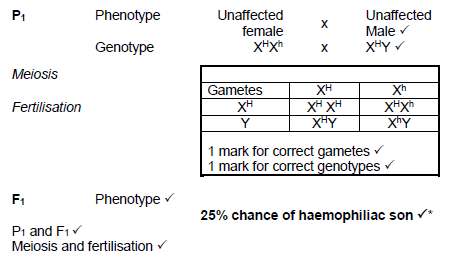
(Any 5 + 1* compulsory) (6)
2.4.1 Accommodation √ (1)
2.4.2
- B √/ D (1)
- E √ (1)
2.4.3
- The ciliary muscles relax √
- Suspensory ligaments become taut √/ stretched
- and the lens becomes less convex √/ flatter
- decreasing the refractive power of the lens √
- maintaining a clear image (4)
2.5
2.5.1
- Corpus luteum √ (1)
- Ovulation √ (1)
2.5.2 Oestrogen √(1)
2.5.3
- FSH will not be released √therefore
- no follicles will develop √in the ovaries
- LH will not be released √therefore
- no ovulation √will occur
- The female will be infertile √/ cannot have babies (Any 4) (4)
2.5.4
- It continues secreting progesterone √
- To further increase the thickness of the endometrium√
- For possible implantation √ (3)
[50]
QUESTION 3
3.1
3.1.1
- 2 – Semi-circular canals √
- 3 – Auditory nerve √ (2)
3.1.2
- 5 – Equalises pressure on either side of the tympanic membrane √
- 6 – Transmits vibrations (sound waves) to the ossicles (middle ear) √ (2)
3.1.3
- A change in the position of the head
- stimulates the maculae √
- in the utriculus and sacculus √
- to convert the stimulus into an impulse √
- The impulse is sent to the cerebellum √
- through the auditory nerve √
- The cerebellum sends impulses to the skeletal muscles √
- to restore balance √ (Any 5) (5)
3.1.4
- Vibrations are not transmitted to the inner ear √
- Pressure waves not generated in cochlea √
- Organ of Corti is not stimulated √
- No impulse is transmitted to cerebrum √
- resulting in impaired hearing √ (Any 3) (3)
3.2
3.2.1
- Its larvae eat the contents of maize stems √
- this weakens the stems causing the plants to collapse √ (2)
3.2.2
- The spray may not reach all the larvae √ as
- they develop inside the stem √ and therefore
- are shielded from the spray √ (3)
3.2.3
- Type of treatment √/ protection (1)
- Number of maize plants collapsed √ (1)
3.2.4
- As a control √
- for comparison of results √ with and without treatment (2)
3.2.5 Average number of plants collapsed
- Plot B = 0+0+22+0+1+11+2+0+1+6+13+17 √
12
= 6,08 √/ 6,1/ 6
Plot C = 1+0+21+0+0+12+1+1+0+0+1+0 √
12
= 3,08 √/3,1/3
(4)
3.2.6 Using genetically modified Bt corn is more effective √ in protecting the maize against the corn borer moth than spraying the corn with Bt toxin √ (2)
3.2.7
- Long period of investigation √/ 12 weeks
- Large sample used √/ Several hundreds of seedlings used (2)
3.2.8 Different scientists used for counting √/ each scientist may have counted differently from the other (1)
3.3
3.3.1
- For the body to be able to react to stimuli √
- To co-ordinate the various activities of the body √ (2)
3.3.2
- E √ – corpus callosum √ (2)
- C √ – spinal cord √ (2)
3.3.3
- The medulla oblongata regulates vital life processes √ like breathing rate √/heart rate (2)
- The right cerebral cortex controls the left-hand side of the body √ A blood clot in the right cerebral cortex will inhibit voluntary action on the left-hand side of the body √ (2)
3.4
3.4.1
- Placenta √(1)
- Umbilical cord √ (1)
3.4.2
- It provides the fluid medium for free movement of fetus √
- It acts as a shock absorber
- It protects the fetus against dehydration √
- It protects the fetus against temperature changes√ Promotes lung development √
- Holds waste √
(Mark first ONE only) (Any 1) (1)
3.4.3 Respiratory √/Gaseous exchange system Digestive √system
Excretory √ system
(Mark first TWO only) (Any 2) (2)
3.4.4
| Vein | Artery |
| Oxygen content – High√ | Oxygen content – Low√ |
| Nutrient content – High√ | Nutrient content – Low√ |
| CO2 content – Low√ | CO2 content – High√ |
| Nitrogenous waste – Low√ | Nitrogenous waste – High√ |
(Mark first ONE only) 1 for table + Any (1 x 2 ) (3)
3.4.5
- High levels of progesterone √
- inhibit the secretion of FSH√ (2)
[50]
TOTAL SECTION B: 100
GRAND TOTAL: 150
Life Sciences Questions - Grade 12 June 2021 Exemplars
INSTRUCTIONS AND INFORMATION
Read the following instructions carefully before answering the questions.
- Answer ALL the questions.
- Write ALL the answers in your ANSWER BOOK.
- Start the answers to EACH question at the top of a NEW page.
- Number the answers correctly according to the numbering system used in this question paper.
- Present your answers according to the instructions of each question.
- ALL drawings must be done in pencil and labelled in blue or black ink.
- Draw diagrams, flow charts or tables only when asked to do so.
- The diagrams in this question paper are NOT necessarily drawn to scale.
- Do NOT use graph paper.
- You must use a non-programmable calculator, protractor and a compass where necessary.
- Write neatly and legibly.
QUESTIONS
SECTION A
QUESTION 1
1.1 Various options are given as possible answers to the following questions. Choose the correct answer and write only the letter (A–D) next to the question number (1.1.1–1.1.9) in the ANSWER BOOK, for example 1.1.10 D.
1.1.1 Which of the following cell structures is the site of DNA replication?
- Nucleus
- Ribosome
- Nucleolus
- Rough endoplasmic reticulum
1.1.2 One of the functions of the amnion is to …
- serve as a reserve food supply.
- give rise to the placenta.
- prevent the developing foetus from moving about.
- enclose the fluid that protects the embryo against injury.
1.1.3 Which ONE of the following correctly describes a difference between DNA and RNA?
DNA | RNA | |
A | Deoxyribose sugar | Ribose sugar |
B | Uracil | Thymine |
C | Single stranded | Double stranded |
D | Different number of cytosine and guanine nitrogen bases | Same number of cytosine and guanine nitrogen bases |
1.1.4 The ABO blood group system of humans is an autosomal trait that has three alleles as follows: IA, IB, i. In this system four different blood groups exist. They are groups A, B, AB and O. In a family of four children, each child has different blood group with respect to this gene. The phenotypes of the parents must be …
- AB and O.
- A and B.
- B and AB.
- O and B.
1.1.5 A pair of homologous chromosomes involved in normal meiosis carries the alleles as shown below.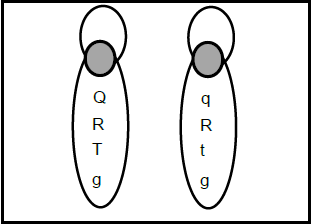
Chromosomes detected in eggs would include: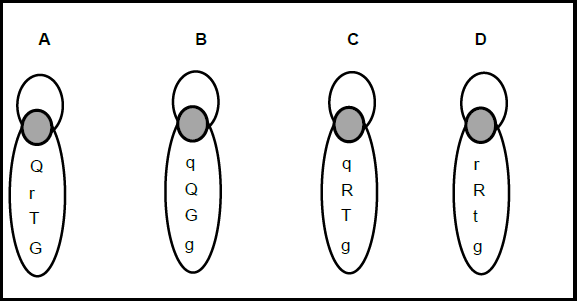
1.1.6 A homozygous recessive individual is crossed with a heterozygous individual.
What is the chance of getting an offspring with a homozygous recessive genotype?
- 25%
- 50%
- 75%
- 100%
1.1.7 The amount of DNA in various types of chicken was measured. The following results were obtained.
CELL TYPE | PICTOGRAMS OF DNA |
R | 2,55 |
S | 2,61 |
X | 1,26 |
Y | 2,54 |
From this data it is reasonable to conclude that the cell most likely to be a sperm is …
- cell type R.
- cell type S.
- cell type X.
- cell type Y.
1.1.8 Study the diagram below.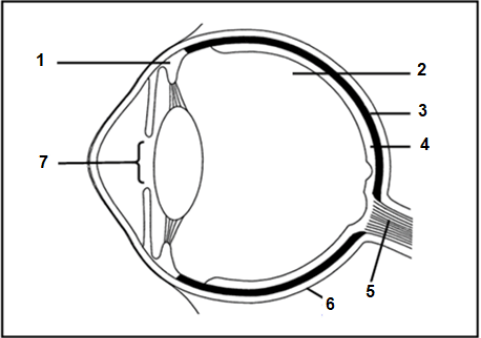
Which ONE of the following correctly represents the labelled structures?
- 3 – blind spot; 4 – choroid
- 2 – vitreous humour; 1 – suspensory ligaments
- 5 – optic nerve; 7 – pupil
- 6 – conjunctiva; 3 – yellow spot
1.1.9 The DNA profiles of a mother and father and four children are shown in the diagram below.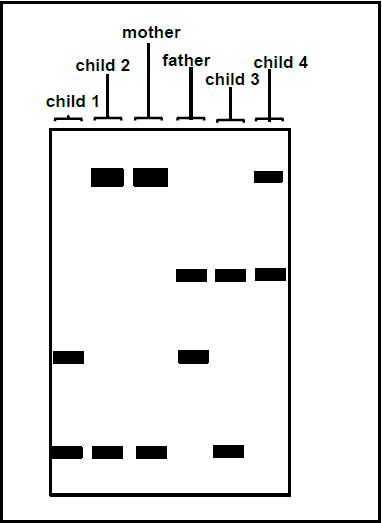
Which child is LEAST LIKELY to be the biological offspring of this couple?
- Child 1
- Child 2
- Child 3
- Child 4 (9 x 2) (18)
1.2 Give the correct biological term for each of the following descriptions. Write only the term next to the question number (1.2.1–1.2.7) in the ANSWER BOOK.
1.2.1 A hollow ball of cells formed from the zygote
1.2.2 The type of fertilisation associated with vivipary
1.2.3 The bonds between amino acids in a protein molecule
1.2.4 A blood vessel in the umbilical cord that transports nutrients to the foetus
1.2.5 A section of DNA that carries the code for a particular trait
1.2.6 Small tubes placed in the tympanic membrane to drain liquid from the middle ear
1.2.7 Tangled network of chromosomes located within the nucleus (7 x 1) (7)
1.3 Indicate whether each of the statements in COLUMN І applies to A ONLY, B ONLY, BOTH A and B or NONE of the items in COLUMN ІІ. Write A only, B only, both A and B or NONE next to the question number (1.3.1–1.3.3) in the ANSWER BOOK.
COLUMN І | COLUMN ІІ | |
1.3.1 A type of development in birds in which the young are capable of moving around soon after hatching | A: | Altricial development |
B: | Precocial development | |
1.3.2 All genes in all the chromosomes of a species | A: | Genotype |
B: | Genome | |
1.3.3 The advantage of the amniotic egg | A: | Provides nutrition |
B: | Protects against dehydration | |
(3 x 2) (6)
1.4 In tomato plants the colour of the stem is controlled by two alleles, purple (P) and green (p). The type of leaf is also controlled by two alleles, cut leaf (L) and potato type leaf (l)
The Punnet square below shows the results of a cross between a plant with purple stem and cut leaves and a plant with a green stem and potato type leaves.
1.4.1 Give the:
- Genotype of parent 1 (2)
- Genotype of plant Z (1)
1.4.2 What percentage of plants have green stems with potato type leaves? (2)
1.5 The diagram below represents a reflex arc.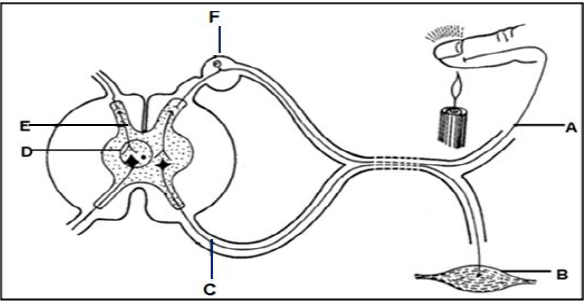
1.5.1 Give the LETTER and NAME of the part that:
- Transmits impulses to the cell body (2)
- Controls one-directional transmission of impulses (2)
- Transmits impulses from the sensory neuron to the correct motor neuron (2)
1.5.2 Give only the LETTER of the:
- Effector (1)
- Neuron that is damaged when a person is able to feel pain, but cannot react to stimulus (1)
1.6 The diagram below represents the structure of the male reproductive system.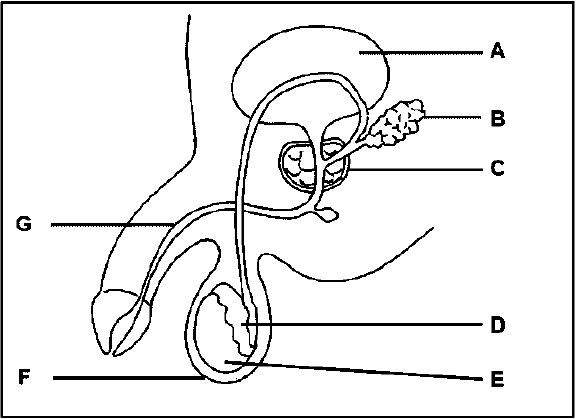
1.6.1 Identify:
- C (1)
- D (1)
1.6.2 Give the LETTER and NAME of the part:
- That carries sperm and urine out of the body (2)
- Which produces the male sex hormone testosterone (2)
TOTAL SECTION A: 50
SECTION B
QUESTION 2
2.1 The following diagram represents stages of protein synthesis.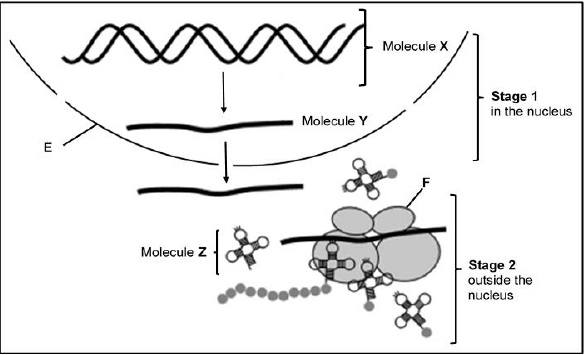
2.1.1 Identify:
- Structure E (1)
- Molecule X (1)
2.1.2 Give the function of molecule Y in protein synthesis. (1)
2.1.3 Name and describe the events occurring at stage 2 as shown in the above diagram.(6)
2.1.4 The sequence of nitrogenous bases shown below belongs to a section of a DNA molecule.
AAA-GTA-CTG-CGC
- What does A represent in this sequence? (1)
- Give the corresponding sequence of nitrogenous bases that will be found in molecule Y.(2)
- Give the corresponding anticodon that corresponds to triplet 2 from left to right in the sequence given above.(2)
2.2 The diagrams below show a pair of homologous chromosomes during meiosis. Diagram I show the whole chromosomes and Diagram II is an enlarged view of the section encircled in Diagram I.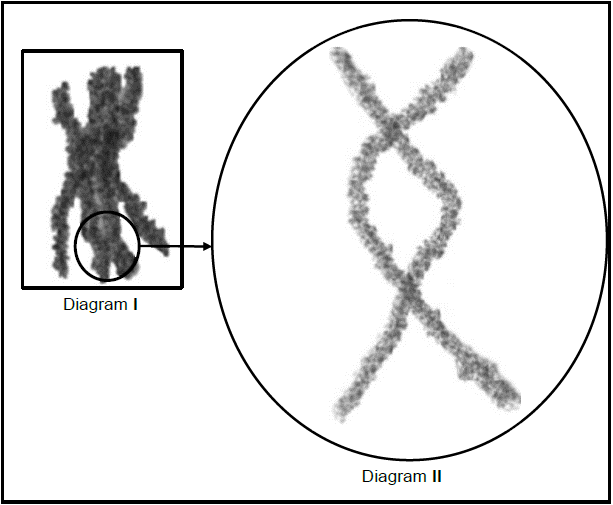
2.2.1 Name the phase during meiosis that would be occurring for this arrangement of chromosomes to be observed. (1)
2.2.2 Name and describe the process occurring in the circled area in Diagram I. (5)
2.2.3 Explain the significance of the process mentioned in QUESTION 2.2.2 for gametogenesis. (2)
2.3 Haemophilia is a sex-linked genetic condition caused by a recessive allele carried on the X chromosome (Xh). The following diagram shows a portion of a family in which some members have haemophilia. Haemophiliac individuals are shaded in the diagram.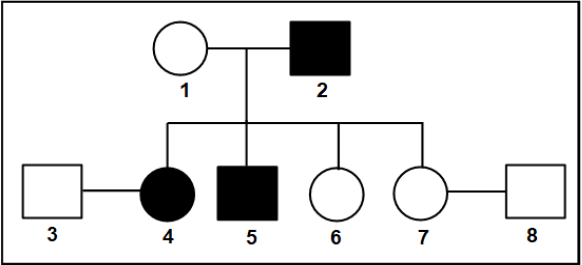
2.3.1 Name the type of diagram shown above. (1)
2.3.2 How many:
- Children are males (1)
- Males have haemophilia (1)
2.3.3 Use appropriate letters to indicate the genotype of each of the following:
- Individual 1 (1)
- Individual 2 (1)
2.3.4 Use a genetic cross to show the percentage chance of individual 7 who is heterozygous and individual 8 producing a son with haemophilia.(6)
2.4 The graph below shows the results of the degree of convexity of a participant’s lens measured over a period of time. During the time indicated, the participant was asked to look at an object which could be moved closer to or further away from the participant.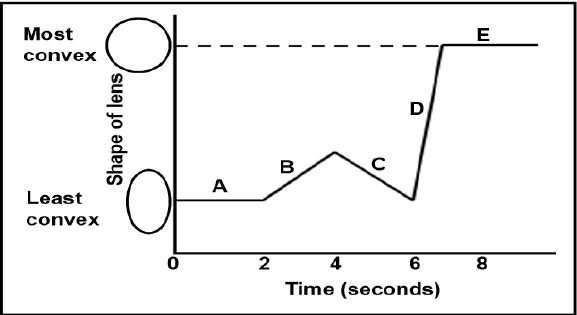
2.4.1 Name the process that changed the shape of the lens. (1)
2.4.2 Give the LETTER on the graph that indicates the period of time during the investigation when the object was:
- Moving towards the participant (1)
- Closest to the participant (1)
2.4.3 Describe how a clear image is maintained during period C on the graph.(4)
2.5 Below is a diagram showing the development of the follicle leading to the production of the structure that produced structure A.
2.5.1 Identify:
- Structure C (1)
- Process B (1)
2.5.2 Name the hormone produced by the follicle before process B. (1)
2.5.3 Explain the consequence in a 25-year-old female with regard to the ovarian cycle if her pituitary gland does not secrete hormones.(4)
2.5.4 Explain the importance of structure C remaining constant after process B.(3)
[50]
QUESTION 3
3.1 The diagram below shows the structure of the human ear.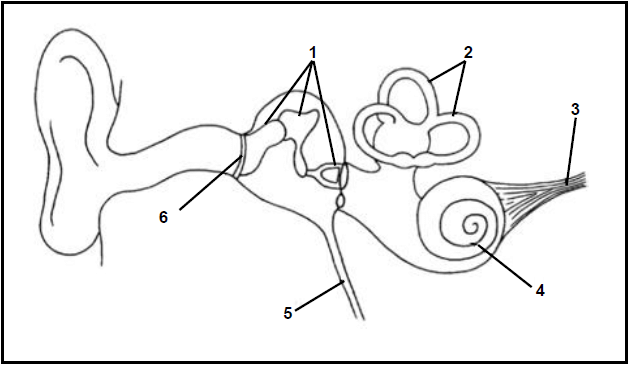
3.1.1 Identify parts labelled 2 and 3. (2)
3.1.2 Give ONE function of each of the parts labelled 5 and 6. (2)
3.1.3 Describe the role played by part labelled 2, in maintaining balance when the position of the head changes. (5)
3.1.4 If structures labelled 1 were not attached to each other, briefly explain the impact this would have on hearing. (3)
3.2 Read the extract below.
The European corn borer moth, Ostrinia nubilalis, is a pest. Its larvae develop inside maize stems and eat the contents, weakening the stems so that the plants collapse. The bacterium, Bacillus thuringiensis (‘Bt’), produces a protein that poisons the larvae of moths and butterflies. This can be isolated from cultures of Bt and packaged in fluids to be sprayed on surface of plants. The gene coding for the toxic protein has also been isolated and incorporated into a genetically modified strain of maize called Bt corn. This makes the plant tissues to be poisonous to the corn borer moth. |
3.2.1 Describe ONE disadvantage of European corn borer moth in plants. (2)
3.2.2 A farmer wants to increase the yield of maize.
Explain why you would not recommend spraying the unmodified corn with Bt toxin. (3)
3.2.3 Some scientists investigated the different ways of protecting maize against the corn borer moth.
The method they followed is described below:
- Several hundreds of maize seedlings were planted in three separate but close together plots, in the same field
- The seedlings in the three plots were treated as follows:
- Plot A was untreated
- Plot B was sprayed daily with Bt toxin
- Plot C the seedlings planted were genetically modified Bt corn
- On the first day of each week, one scientist would walk around the edge of a plot and count the number of maize plants that had collapsed
- Each plot had a scientist responsible for counting
The results are shown in the table below.
Number of maize plants collapsed since the last weekly count | |||
Week number | Plot A | Plot B | Plot C |
1 | 0 | 0 | 1 |
2 | 0 | 0 | 0 |
3 | 18 | 22 | 21 |
4 | 0 | 0 | 0 |
5 | 5 | 1 | 0 |
6 | 14 | 11 | 12 |
7 | 5 | 2 | 1 |
8 | 12 | 0 | 1 |
9 | 17 | 1 | 0 |
10 | 30 | 6 | 0 |
11 | 32 | 13 | 1 |
12 | 41 | 17 | 0 |
State the:
- Independent variable (1)
- Dependent variable (1)
3.2.4 Why was Plot A included in the investigation? (2)
3.2.5 Calculate the average number of maize plants collapsed in Plots B and C respectively. (4)
3.2.6 Based on the calculations done in QUESTION 3.2.5, what conclusions can be drawn with regards to the effectiveness of the method followed in Plot B and C in protecting maize against the corn borer moth. (2)
3.2.7 State TWO ways in which the scientists ensured reliability of this investigation. (2)
3.2.8 Describe ONE way in which this investigation is invalid. (1)
3.3 The diagram below shows parts of the human nervous system.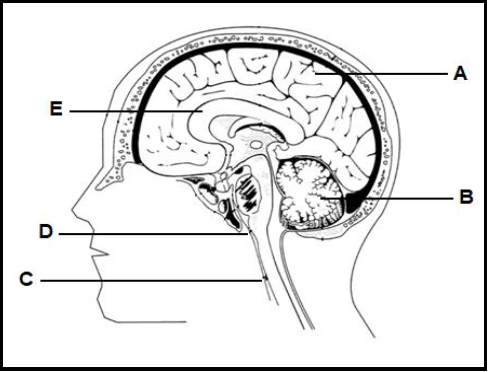
3.3.1 Give TWO reasons why humans need a nervous system. (2)
3.3.2 Give the LETTER and NAME of the part that has the following function:
- Allows communication between cerebral hemispheres (2)
- Controls reflex actions (2)
3.3.3 Explain each of the following observations by referring to the function and the part of the brain indicated:
- Damage to part labelled D results in death, even if all the other parts of the brain and the body are functioning (2)
- blood clot in the right half of the part labelled A may result in paralysis in the left arm (2)
3.4 The diagram below represents a developing foetus in a human body.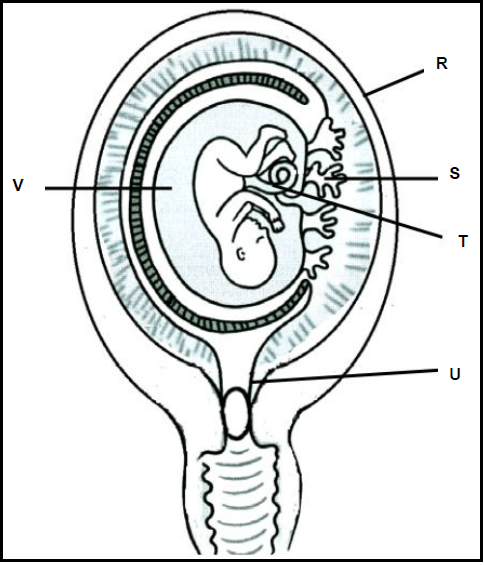
3.4.1 Identify:
- S (1)
- T (1)
3.4.2 State ONE function of the fluid labelled V. (1)
3.4.3 Name TWO systems in the baby’s body that take over the function of part S once the baby is born.(2)
3.4.4 Tabulate ONE difference in the composition of the blood in a vein and in an artery found in structure T.(3)
3.4.5 Explain what prevents another ovum being produced while the foetus is developing in a human body.(2)
[50]
TOTAL SECTION B: 100
GRAND TOTAL: 150
History Paper 2 Memorandum - Grade 12 June 2021 Exemplars
MEMORANDUM
SECTION A: SOURCE-BASED QUESTIONS
QUESTION 1: HOW DID SOUTH AFRICANS REACT TO P.W. BOTHA’S REFORMS IN THE 1980s?
1.1
1.1.1 [Extraction of information from Source 1A – L1]
- It granted rights to African trade unions
- Allowed privileges for the urban African workforce
- Create a black middle class (Any 2 x 1) (2)
1.1.2 [Interpretation of evidence from Source 1A – L2]
- The government hoped that there would be fewer uprisings in the townships
- The house owners would not tolerate the uprisings as it might damage their houses/property
- Any other relevant response (Any 1 x 2) (2)
1.1.3 [Extraction of information from Source 1A – L1]
- Advertising campaigns
- New loans were made available (2 x 1) (2)
1.2
1.2.1 [Interpretation of evidence of from Source 1B – L2]
- The apartheid government used harsher methods to oppress uprisings
- Many of the political leaders were in jail or in exile
- Any other relevant response (2 x 2) (4)
1.2.2 [Extraction of information from Source 1B – L1]
- Reverend Allan Boesak
- Albertina Sisulu
- Patrick ‘Terror” Lekota (Any 2 x 1) (2)
1.2.3 [Extraction of information from Source 1B – L1]
- Freedom from the apartheid regime (1 x 2) (2)
1.2.4 [Interpretation of evidence of from Source 1B – L2]
- They had the same goal and that was to end apartheid
- As the ANC was banned, it called on the UDF to increase internal pressure on the government
- Any other relevant response (2 x 2) (4)
1.2.5 [Evaluating the usefulness of Source 1B – L3]
The source is useful because:
- It coordinated the anti-apartheid groups so that effective protests could be launched
- The UDF brought together many different anti-apartheid organisations across the country
- As it was a loose alliance, the government could not easily destroy it
- The UDF made the country ungovernable through various campaigns
- Any other relevant response (Any 2 x 2) (4)
1.3
1.3.1 [Interpretation of evidence from Source 1C – L2]
- To discourage Coloured and Indians from participating in the elections for the Tri-cameral parliament
- The reforms were seen as cosmetic and the political power would still remain in the hands of the white minority
- The fact that black South Africans were left out of the new parliamentary system
- Any other relevant response (Any 2 x 2) (4)
1.3.2 [Extraction of information from Source 1C – L1]
- ‘Don’t Vote’ campaign (1 x 2) (2)
1.3.3 [Interpretation of evidence from Source 1C – L2]
- To make people aware of the need to organise and actively resist apartheid
- To mobilise South Africans to fight against discrimination and oppression
- Any other relevant response (2 x 2) (4)
1.4 [Comparison of Source 1B and Source 1C – L3]
- Source 1B indicates that the UDF became a mass-based organisation and Source 1C shows the many people/organisations that were affiliated to the UDF
- Source 1B refers to resistance campaigns launched by the UDF and Source 1C show the ‘Don’t Vote’ campaign
- Source 1B indicates that the goal was to get freedom from the apartheid regime and Source 1C shows them fighting for freedom
- Any other relevant response (Any 2 x 2) (4)
1.5
1.5.1 [Explanation of historical concept from Source 1D – L1]
- The power of the ordinary people to bring change
- To insist on a government that represents their interests
- Any other relevant response (Any 1 x 2) (2)
1.5.2 [Extraction of information from Source 1D – L1]
- Rent boycotts
- Consumer boycotts (2 x 1) (2)
1.5.3 [Interpretation of evidence from Source 1D – L2]
- The rent money was not used to improve the conditions/facilities in their communities
- The black councillors who collected the rent became corrupt and were seen as ‘sell-outs’
- Any other relevant response (Any 1 x 2) (2)
1.6 [Interpretation, evaluation and synthesis of evidence from relevant sources- L3]
Candidates could include the following aspects in their response:
- Black South Africans saw Botha’s reforms as cosmetic (own knowledge)
- Tri-cameral parliament was rejected by black South Africans (own knowledge)
- UDF formed to oppose apartheid (Source 1B)
- UDF coordinated the actions against apartheid (Source 1B)
- Protests, rent and consumer boycotts held (Source 1B and Source 1D)
- Different organisations affiliated to the UDF (Source 1B)
- UDF held anti-elections campaigns (Source 1C)
- People demanded freedom (Source 1C)
- Civic organisations fought for better conditions in townships (Source 1D)
- Workers, student organisations and churches joined the protest actions against apartheid (own knowledge)
- Any other relevant response
Use the following rubric to allocate marks:
LEVEL 1 |
| MARKS 0–2 |
LEVEL 2 |
| MARKS 3–5 |
LEVEL 3 |
| MARKS 6–8 |
(8) [50]
QUESTION 2: HOW SUCCESSFUL WAS THE TRUTH AND RECONCILIATION COMMISSION (TRC) IN DEALING WITH THE DEATH OF ACTIVIST LENNY NAIDU?
2.1
2.1.1 [Extraction of information from Source 2A – L1]
- Umkhonto we Sizwe (MK) (1 x 2) (2)
2.1.2 [Extraction of information from Source 2A – L1]
- Advancing the ideas of non-racialism and unity
- Fighting for freedom
- Striving to improve the quality of life of all people (3 x 1) (3)
2.1.3 [Interpretation of evidence from Source 2A – L2]
- If caught he would be jailed or killed by the apartheid system
- He openly rebelled against apartheid and was thus perceived as a threat
- Could not operate freely to dismantle apartheid
- Determined to fight against the unjust apartheid system
- Any other relevant response (Any 2 x 2) (4)
2.1.4 [Interpretation of evidence from Source 2A – L2]
- He was waiting to execute the instructions or orders from the ANC in South Africa
- Which government institutions he had to attack/destroy
- Any other relevant response (Any 1 x 2) (2)
2.2
2.2.1 [Extraction of evidence from Source 2B – L1]
- If caught he would be jailed or killed by the apartheid system
- He would have been charged for being a member of the ANC
- Charged without a passport (Any 2 x 1) (2)
2.2.2 [Extraction of evidence from Source2B – L1]
- Eugene De Kock
- Mr Nafumela (2 x 1) (2)
2.2.3 [Interpretation of evidence of from Source 2B – L2]
NO.
- The commissioner told them to wait for full disclosure at the amnesty hearing
- They will find a lead of what happened at the hearing
- Any other relevant response (Any 1 x 2) (2)
2.2.4 [Extraction of evidence from Source 2B – L1]
- Murder (1 x 2) (2)
2.2.5 [Evaluating the reliability of Source 2B – L3]
The source is reliable because:
- The parents and brother were convinced that Lenny was murdered
- Both de Kock and Nafumela are guilty because they applied for amnesty
- They were able to speak their hearts out and get some kind of closure
- Any other relevant response
OR
The source is not reliable because:
- It did not give full disclosure because the commissioner told them they still have to wait for the amnesty hearing
- Both of them still believed that they were innocent by applying for amnesty
- Any relevant response (Any 2 x 2) (4)
2.3
2.3.1 [Extraction of evidence from Source 2C – L1]
- ‘How two sets of Umkhonto we Sizwe cadres were ambushed at Piet Retief’ (1 x 2) (2)
2.3.2 [Interpretation of evidence from Source 2C – L2]
- Swaziland supported the ANC’s fight against the apartheid regime
- Swaziland did not favour white minority rule in South Africa
- Swaziland wanted a free, democratic and liberated South Africa
- Swaziland was one of the closest independent African countries and therefore ANC cadres were able to gain access for onward travel to MK training camps, for example in Lusaka (Zambia)
- Any other relevant response (Any 2 x 2) (4)
2.3.3 [Extraction of evidence from Source 2C – L2]
- Charity Nyembezi
- Makhosi Nyoka
- Nonsikelelo Cothoza (3 x 1) (3)
2.4
2.4.1 [Interpretation of evidence from Source 2D – L2]
- The cartoon shows Eugene de Kock submitting his application for amnesty to the TRC
- It depicts Archbishop Desmond Tutu, the chairperson of the TRC receiving De Kock’s application
- The cartoon shows a very long list of crimes that were committed by De Kock
- Any other relevant response (Any 2 x 2) (4)
2.4.2 [Interpretation of evidence from Source 2D – L2]
- Tutu wanted De Kock to list all the crimes that he had committed before he could apply for amnesty
- De Kock had committed a number of human rights crimes against anti-apartheid activists
- De Kock was famous as a killer of anti-apartheid activist
- Any other relevant response (Any 1 x 2) (2)
2.5 [Comparison of Source 2C and Source 2D – L3]
- Source 2C explains De Kock’s application for amnesty and Source 2D shows De Kock submitting his application for amnesty
- Source 2C reveals many crimes that De Kock had committed and Source 2D shows De Kock with a long list of crimes that he has committed
- Any other relevant response (2 x 2) (4)
2.6 [Interpretation, evaluation and synthesis of evidence from relevant sources – L3]
Candidates could include the following aspects in their response:
- Lenny Naidu was a member of the ANC’s armed wing, Umkhonto we Sizwe (Source 2A)
- Both parents and brother of Lenny Naidu attended the TRC hearing to seek the truth about the murder (Source 2B)
- The commissioner thanked them for coming forward and making a disclosure (Source 2B)
- The TRC revealed the truth about human rights abuses committed from 1960 to 1994 (Source 2C)
- Leslie Naidu appeared before the TRC to give evidence regarding the murder of Lenny Naidu (Source 2B)
- Eugene De Kock and other former security policemen testified about their role regarding the killings of political activists at Piet Retief (Source 2C)
- The truth of how Lenny Naidu was murdered was revealed to the TRC (Source 2C)
- Eugene De Kock submitted the list of crimes he committed to the TRC (Source 2D)
- De Kock applied for amnesty for the murder of Lenny Naidu (Source 2C)
- The TRC was able to solve some murders and disappearances of political activists such as that of Lenny Naidu (own knowledge)
- Any other relevant response
Use the following rubric to allocate marks:
LEVEL 1 |
| MARKS 0–2 |
LEVEL 2 |
| MARKS 3–5 |
LEVEL 3 |
| MARKS 6–8 |
(8) [50]
SECTION B: ESSAY QUESTIONS
QUESTION 3: CIVIL RESISTANCE, 1970s TO 1980s: SOUTH AFRICA
[Plan and construct an original argument based on relevant evidence using analytical and interpretative skills.]
SYNOPSIS
Candidates should critically discuss the role and impact of the Black Consciousness Movement under Steve Biko on black South Africans in the 1970s.
MAIN ASPECTS
Candidates should include the following aspects in their response:
- Introduction: Candidates need to take a stance and discuss the role and impact of the Black Consciousness Movement under Steve Biko on black South Africans in the 1970s.
ELABORATION
- Reason for the formation of the Black Consciousness Movement (Background)
Biko’s philosophy of Black Consciousness (BC)
- Conscientised black people of the evils of apartheid
- Instilled a sense of self-worth and confidence in black South Africans
- Restored black pride
- Changed the way black South Africans saw themselves
- Empowered them to confront apartheid
- Biko urged black South Africans to assert themselves and to do things for themselves
- Eliminated the feeling of inferiority
Role of Steve Biko
- Formation of SASO
- SASO spread BC ideas across the campuses of the ethnically separated universities
- SASO promoted black unity and solidarity
- Made students more politically aware
- Encouraging students to liberate themselves from apartheid
- Biko promoted self-liberation
- He believed that association with whites made the liberation struggle ineffective and that blacks must liberate themselves
- Established self-help groups for black communities with other BC leaders
- BC ideas were published in SASO newsletters
Black Consciousness became a national movement
- In 1972 the Black People’s Convention was formed
- Aimed to liberate black people from both psychological and physical oppression
- Self-help projects were set up e.g. Zanempilo Clinic, Ginsburg, and Zimele Trust Fund
- Led to the formation of the Black Allied Workers Union in 1973
- BC influenced scholars that led to the formation of SASM
Challenges posed by the ideas of BC to the state
- At first the South African government was not concerned about the BCM and assumed it to be in line with its own policy of separate development
- BCM became stronger and posed a challenge to the state
- It became a mass movement that sought to undermine apartheid
- Biko’s speeches encouraged black South Africans to reject apartheid
- BC ideas incited the workers to embark on strike action
- BCM supported disinvestment companies
Government’s reaction to Biko’s philosophy
- Banning and house arrest of Biko and other leaders
- BC leaders were banned from speaking in public
- BPC activists were detained without trail
- SASO was banned on university campuses
- Biko was arrested and interrogated
- Biko was brutally murdered by the security police in 1977
- Any other relevant response
Conclusion: Candidates need to tie up their argument with a relevant conclusion. [50]
QUESTION 4:
THE COMING OF DEMOCRACY TO SOUTH AFRICA AND COMING TO TERMS WITH THE PAST
[Plan and construct an original argument based on relevant evidence using analytical and interpretative skills]
SYNOPSIS
Candidates need to agree or disagree with the statement by discussing the commitment and leadership displayed by both Mandela and De Klerk that ensured South Africa’s democracy. Relevant examples to South Africa’s road to democracy must be discussed.
MAIN ASPECTS
Candidates should include the following aspects in their essays:
- Introduction: Candidates need to discuss the commitment and leadership role played by Mandela and De Klerk in creating conditions for South Africa’s road to democracy from 1990 to 1994.
ELABORATION
Focus on different role players in the following key historical events and turning points:
- Release of Mandela and unbanning of ANC, PAC and SACP
- The process of negotiations (i.e. Groote Schuur Minute, Pretoria Minute)
- Suspension of the armed struggle
- CODESA 1
- Referendum
- CODESA 2
- Record of Understanding
- Increased violence – Rolling mass action (i.e. Boipatong, Bhisho, etc.)
- Goldstone Commission
- Multi party negotiations
- Death of Hani
- Storming of the World Trade Centre, etc.
- 1994 election – cast ballot in KZN
- ANC won elections and Mandela became the first black South African President
- Any other relevant response
Conclusion: Candidates need to tie up their argument with a relevant conclusion. [50]
QUESTION 5:
THE END OF THE COLD WAR AND A NEW WORLD ORDER: THE EVENTS OF 1989
[Plan and construct an original argument based on relevant evidence using analytical and interpretative skills]
SYNOPSIS
They need to indicate to what extent the disintegration of the Soviet Union in 1989 served as a catalyst for South Africa to begin its political transformation in the 1990s. Candidates must support their given line of argument with relevant historical evidence.
MAIN ASPECTS
Candidates should include the following aspects in their response:
- Introduction: Candidates need to indicate the extent of the disintegration of the Soviet Union in 1989 served as a catalyst for the political transformation that occurred in South Africa in the 1990s.
ELABORATION
In agreeing, candidates could include the following points in their answer:
- The impact of the disintegration of the Soviet Union in 1989 on South Africa
- Gorbachev’s reform policies of Glasnost and Perestroika
- The communist regimes in Eastern Europe collapsed
- The Berlin Wall had fallen
- Changes in the world contributed to the end of apartheid
- The collapse of the USSR deprived the ANC of its main source of support (financial; military and moral and its consequences)
- The National Party claim that it was protecting South Africa from a communist onslaught became unrealistic
- Western world powers supported the move that South Africa resolve its problems peacefully and democratically
- It became evident the National Party government could not maintain white supremacy indefinitely
- Influential National Party members started to realise that apartheid was not the answer to the needs of white capitalist development
- The Battle of Cuito Cuanavale and its consequences
- The security forces and state of emergency had not stopped township revolts
- By the late 1980s South Africa was in a state of economic depression
- The role of business leaders in South Africa’s political transformation
- PW Botha suffered a stroke and was succeeded by FW de Klerk
- FW De Klerk started to accept that the black South African struggle against apartheid was not a conspiracy directed from Moscow
- This enabled De Klerk to engage in discussions with the liberation organisations
- On 2 February 1990, De Klerk announced ‘a new and just constitutional dispensation’
- This signalled the end of apartheid
- Any other relevant response
Conclusion: Candidates need to tie up their argument with a relevant conclusion. [50]
TOTAL: 100
History Paper 1 Memorandum - Grade 12 June 2021 Exemplars
MEMORANDUM
SECTION A: SOURCE-BASED QUESTIONS
QUESTION 1: HOW DID BERLIN BECOME A FOCAL POINT OF THE COLD WAR AFTER 1945?
1.1
1.1.1 [Extraction of evidence from Source 1A – L1]
- Germany should be divided into four zones. (1 x 2) (2)
1.1.2 [Definition of concept from Source 1A – L1]
- Cold War is a war of words without physical fighting.
- It is an ideological struggle between capitalist West and Communist East.
- A period of tension from end of WW2 to 1989. (1 x 2) (2)
1.1.3 [Interpretation of evidence from Source 1A – L2]
- Germany was to be divided so that it cannot start the war again.
- To limit its power and expansion.
- Berlin was a capital city that fell into Russian side, so the Western allies wanted to benefit from it
- Any other relevant response (Any 2 x 2) (4)
1.1.4 [Interpretation of evidence from Source 1A – L2]
- The USA and USSR were together after WW2 and now they are fighting each other
- Neither USA nor USSR wanted to submit to each other in this confrontation
- They are in a stage of hostility to each other
- Any other relevant response (Any 2 x 2) (4)
1.1.5 [Extraction of evidence from Source 1A – L1]
- London
- Washington
- Paris (Any 3 x 1) (3)
1.2
1.2.1 [Extraction of evidence from Source 1B – L1]
- Occurred in 1948 (1 x 1) (1)
1.2.2 [Extraction of evidence from Source 1B – L1]
- Partial blockade of Berlin in April
- Full blockade in June (Any 2 x 1) (2)
1.2.3 [Extraction of evidence from Source 1B – L1]
- The institution of the Marshall Plan for European Recovery
- The London Conferences of Winter and Spring of 1948
- The resultant London Programme which called for a separate West Germany and Currency Reform as a means to reach this end (Any 2 x 1) (2)
1.2.4 [Interpretation of evidence from Source 1B – L2]
- Western Allies introduced airlifts
- Any other relevant response (1 x 2) (2)
1.2.5 [Interpretation of evidence from Source 1B – L2]
- His objectives were not successful
- The Western Allies continued to supply Western Berliners
- Western Germany was already separated from East Germany
- Any other relevant response (2 x 2) (4)
1.2.6 [Determining the usefulness of the evidence from Source 1B – L3]
- The source states the reasons why the Berlin Blockade was initiated
- Blockade was initiated because of the division of Berlin
- It occurred when Germany was divided into Federal Republic and Democratic Republic
- Any other relevant response (Any 2 x 2) (4)
1.3
1.3.1 [Extraction of evidence from Source 1C – L1]
- Democracy (1 x 2) (2)
1.3.2 [Interpretation of evidence from Source 1C – L2]
- Berlin Blockade created more tension between East and West
- The Western Allies formed NATO for any attack
- USSR formed Warsaw Pact for any attack to counteract NATO
- Any other relevant response (Any 1 x 2) (2)
1.4. [Interpretation of evidence from Source 1D – L1]
- Russia wanted to control the whole Berlin, its arms folding around Berlin
- Stalin closed all the access routes to Berlin preventing USA, Britain and France to supply berlin with necessities
- Britain, France and United States have a share in Berlin, their flags flying inside Berlin
- Any other relevant response (Any 2 x 2) (4)
1.5 [Interpretation of evidence from Source 1D – L2]
- Source 1A states that Berlin was divided into four zones. Source 1D shows the division where there is a British, French and American flag and also the ‘Soviet occupation’
- Source 1A states that there were disagreements in the division of Berlin. Source 1D shows the disagreement in which this figure representing USSR wanted to occupy the whole Berlin
- Any other relevant responses (Any 2 x 2) (4)
1.6 [Interpretation, analysis and synthesis of evidence from relevant sources - L3]
- The Yalta allies decided to divide Germany and Berlin into four zones of occupation
- In Potsdam each occupying power could remove property and reparations from own zone, but not sabotage German economic stability (Own knowledge)
- World opinion is in favour of peace and wanted Russia to withdraw their missiles from Cuba and the US to suspend the blockade against Cuba (Source 1C)
- US and USSR agree to end crisis by withdrawing US missiles in Turkey in exchange for Russian withdrawal of missiles from Cuba (Source 1D and own knowledge)
- Compromise leads to end of crisis (Own knowledge)
- Cuba's independence is guaranteed (Own knowledge)
- Any other relevant response
Use the following rubric to allocate a mark:
CRITERIA | ||
LEVEL 1 |
| 0–2 |
LEVEL 2 |
| 3–5 |
LEVEL 3 |
| 6–8 |
(8) [50]
QUESTION 2: WHY DID FOREIGN POWERS BECOME INVOLVED IN THE ANGOLAN WAR OF INDEPENDENCE?
2.1
2.1.1 [Definition of historical concepts from Source 2A – L1]
- An economic system based on state ownership of the means of production
- An economic system that prohibits the private ownership of property and the means of production
- Any other relevant response (Any1 x 2) (2)
2.1.2 [Extraction of evidence from Source 2A – L1]
- Instinctive fear of communist expansion (1 x 2) (2)
2.1.3 [Extraction of evidence from Source 2A – L1] (2 x 1) (2)
2.1.4 [Interpretation of evidence from Source 2A – L2]
- MPLA was communist
- MPLA was opposed to SA's apartheid policy
- MPLA allowed ANC to open bases to continue the armed struggle against SA
- MPLA allowed SWAPO to set up bases to continue the struggle for independence
- Any other relevant response (Any 2 x 2) (4)
2.1.5 [Interpretation of evidence from Source 2A – L2]
- Both organisations wanted to win SA's support, promising that they would ban SWAPO activities in Angola
- SWAPO used Angola to continue the armed struggle against SA – if they were denied access through Angola they would not be able to continue the struggle for the independence of Namibia
- Any other relevant response (Any 2 x 2) (4)
2.2
2.2.1 [Extraction of evidence from Source 2B – L1]
- The Soviet Union and Cuba
- The USA (2 x 1) (2)
2.2.2 [Extraction of evidence from Source 2B – L1]
- ‘The Angolan people had requested their protection against imperialist aggression ...’ (1 x 2) (2)
2.2.3 [Interpretation of evidence from Source 2A – L2]
- The US was opposed to the communist invasion of Angola because it would jeopardise their capitalist interests there.
- US interference was based on economic interests and not ideological beliefs
- USA had rights to extract oil in Angola – Chevron
- US could not afford to lose oil contract as the Arab countries launched an oil boycott against her in the 1970s.
- Angola's natural resources were a major source of revenue for the US and therefore Russian interference had to be stopped at all costs.
- Any other relevant response (Any 2 x 2) (4)
2.2.4 [Evaluation of the usefulness of Source 2B – L3]
Useful to a great extent
- It was written by a knowledgeable historian
- The information can be confirmed by other historical sources
- The source gives the reasons for the foreign intervention in Angola
- The source also emphasises that the reasons for the interference were not only ideological but also economic.
- Any other relevant response (Any 2 x 2) (4)
2.3
2.3.1 [Extraction of evidence from Source 2C – L1]
- They sent arms
- They sent instructors (2 x 1) (2)
2.3.2 [Interpretation of evidence from Source 2C – L2]
• Cuba had no intention of participating in the Angolan War of Independence
• Cuba had no plans to become involved in the Angolan conflict
• Cuban involvement would only take place if requested
• Any other relevant response (Any 1 x 2)
(2)
2.3.3 [Extraction of evidence from Source 2C – L1]
- At the request of the MPLA
- To help the Angolan patriots (loyalists) resist the invasion of the South African racists. (2 x 1) (2)
2.3.4 [Determining reliability of Source 2C – L3]
Reliable to a great extent
- It is a primary source – give first-hand information
- Castro was the president of Cuba and was directly involved in the conflict
- The date of the source corresponds with the date of the civil war
- Any other relevant response (Any 2 x 2) (4)
2.4
2.4.1 [Interpretation of evidence from Source 2D – L2]
- To show that they were proud of their victory over the SADF and UNITA
- To show that the military force of the SADF was vulnerable.
- It shows their determination to ensure that the MPLA and communism in Angola were protected
- Any other relevant response (Any 2 x 2) (4)
2.4.2 [Interpretation of evidence from Source 2D – L2]
- SADF would have regarded it as propaganda
- SADF wanted revenge
- Any other relevant response (Any 1 x 2) (2)
2.5 [Interpretation, analysis and synthesis of evidence from relevant sources – L3]
Candidates may include the following aspects in their responses:
- SA opposed to the communist MPLA. (Source 2A)
- SA supports UNITA and FNLA because they were anti-communist (Source 2A)
- Both UNITA and FNLA pledged to counter SWAPO attacks on South Africa. (Source 2A)
- Russia and the US became involved due to economic and ideological reasons (Source 2B)
- US wanted to contain the spread of communism in Angola and Southern Africa (Source 2B)
- The US had oil contracts in Angola and was opposed to communist expansion which would put it at risk. (Own knowledge and Source 2B)
- Russia and Cuba supported the MPLA because they were communist (Source 2B)
- Russia and Cuba intervened because the MPLA requested help (Source 2B)
- Angola's geographical location was of strategic value to both the USA and Russia (Source 2C)
- Cuba became involved at the request of the MPLA (Source 2C)
- Cuba became involved to stop the South African military's advance in Angola (Source 2C)
- Foreign involvement led to war between the MPLA and UNITA and SADF (Source 2D)
- SAW defeated during the Battle of Cangamba (Source 2D)
- Any other relevant response
Use the following rubric to allocate a mark:
CRITERIA | ||
LEVEL 1 |
| 0–2 |
LEVEL 2 |
| 3–5 |
LEVEL 3 |
| 6–8 |
(8) [50]
QUESTION 3: HOW DID THE PROCESS OF SCHOOL INTEGRATION UNFOLD AT CENTRAL HIGH SCHOOL IN LITTLE ROCK, ARKANSAS?
3.1
3.1.1 [Extraction of evidence from Source 3A – L1]
- He had received the information that caravans of automobiles filled with white supremacists were heading toward Little Rock
(1 x 2) (2)
3.1.2 [Extraction of evidence from Source 3A – L1]
- He therefore declared Central High School off limits to Negroes
(1 x 2) (2)
3.1.3 [Extraction of evidence from Source 3A – L1]
- To gaze upon the incredible spectacle of an empty school building surrounded by 250 armed National Guard troops.
(1 x 2) (2)
3.1.4 [Interpretation of evidence from Source 3A – L2]
- African Americans will die
- Many people will be killed
- Plenty of bloodshed if integration will be allowed at Little Rock
(1 x 2) (2)
3.1.5 [Determining the usefulness of Source 3A – L3]
The source is USEFUL:
- It outlines the role played by Daisy Bates to bring an end to segregation at Little Rock
- Daisy Bates had been communicating with Little Rock Nine parents
- Any other relevant response (2 x 2) (4)
3.2
3.2.1 [Extraction of evidence from Source 3B – L1]
- ensure the protection of all students (1 x 2) (2)
3.2.2 [Extraction of evidence from Source 3B – L1]
- They did not have a telephone
- She was not contacted to let her know that Daisy Bates of the NAACP had arranged for some ministers to accompany the students in a group ( 2 x 1) (2)
3.2.3 [Interpretation of evidence from Source 3B – L2]
- They were racist and full of hatred towards Elizabeth Eckford
- Elizabeth was not welcomed by the mob at Central High School
- The mob was against integration of African Americans
- Any other relevant response (Any 2 x 2) (4)
3.2.4 [Interpretation of evidence from Source 3B – L2]
- Right to human dignity
- Right to security
- Right to freedom of speech
- Right to free movement
- Any other relevant response (Any 2 x 2) (4)
3.3
3.3.1 [Interpretation of evidence from Source 3C – L2]
- To show how violent the mob was to Elizabeth Eckford as they are shouting her
- To show that this white mob did not want integration, they are chasing her out of the school surroundings
- Any other relevant response (Any 2 x 2) (4)
3.3.2 [Interpretation of evidence from Source 3C – L2]
- She is brave and doesn’t show any fear
- She is confident
- She is calm and in a relax mood
- Any other relevant response (Any 1 x 2) (2)
3.3.3 [Comparison on sources to determine similarities – L3]
- Source 3B states that Elizabeth Eckford tried to squeeze herself out of the white mob as they were denying her an entry to the school. Source 3D shows the white mob following Elizabeth and trying to block her way by chasing her out of the school
- Both sources highlight the fact that the white mob was unfriendly to Elizabeth Eckford
- Source 3B states that the mob started to shout at her by saying ‘Lynch her’. Source 3D shows the white mob shouting at Elizabeth Eckford
- Any other relevant response (Any 2 x 2) (4)
3.4
3.4.1 [Extraction of evidence from Source 3D – L1]
- The three white girls wanted to let her know that they didn’t want her in their school
- The other kids were either egging them on (2 x 1) (2)
3.4.2 [Extraction of evidence from Source 3D – L1]
- Two, four, six, eight! We don’t want to integrate (1 x 2) (2)
3.4.3 [Interpretation of evidence from Source 3D – L2]
- Hazel Bryan was racist
- She did not want integration
- She got the support from the white mob (for her kind of behaviour)
- Any other relevant response (Any 2 x 2) (4)
3.5 [[Interpretation, analysis and synthesis of evidence from relevant sources – L3]
Candidates may include the following aspects in their responses:
- African American students given a chance to attend in a better school
- The white mob decided to come and observe the integration process at Central High School (Source 3A)
- Governor Faubus delivered the infamous words that the blood will run in the streets if Negroes attempt to enter at Central High School (Source 3A)
- Parents of Little Rock Nine were frightened by these infamous words (Source 3A)
- Arrangement for the protection of the Little Rock Nine was made by NAACP (Source 3B)
- As Elizabeth was trying to pass through, the mob moved her away (Source 3B and 3C)
- The mob started to shout Elizabeth calling her by names (Source 3B and 3C)
- She tried to get help from the guards but there was no sign instead some in the white mob spat on her spat (3B and 3C)
- The three girls, motivated by their parents behaved in an unfriendly manner to show that they didn’t want to integrate (Source 3D)
- Hazel Bryan showed an angry face poisoned with hate to Elizabeth Eckford (Source 3D)
- Any other relevant response (8)
Use the following rubric to allocate a mark:
LEVEL | CRITERIA | |
LEVEL 1 |
| 0–2 |
LEVEL 2 |
| 3–5 |
LEVEL 3 |
| 6–8 |
(8) [50]
SECTION B: ESSAY QUESTIONS
QUESTION 4: CASE STUDY – VIETNAM
[Plan and construct an original argument based on relevant evidence using analytical and interpretative skills.]
SYNOPSIS
Candidates must critically discuss why the USA was unable to defeat a small nation of Vietnamese peasants during the Vietnam War between 1963 and 1973.
An outline of the tactics and strategies employed by the USA’s army and the Vietmihn/Vietcong (National Liberation Front) during the war should be highlighted.
MAIN ASPECTS
Candidates may include the following aspects in their response:
Introduction: Candidates should critically discuss the statement and develop a relevant line of argument.
ELABORATION
USA strategies:
Reasons for the USA’s deployment of troops to Vietnam
- Villagisation/strategic hamlet programme (USA and South Vietnam government created new villages and attempted to separate villagers (farmers) from guerrillas) of which it was a failure
- Gulf of Tonkin resolution (1964) gave President Johnson wide military powers resulting in the escalation of warfare in Vietnam
- The USA’s mass aerial bombing – “Operation Rolling Thunder”
- Operation Ranch Hand (used chemicals to destroy forests (Agent Orange) and crops (Agent Blue)
- US sent young and inexperienced soldiers to Vietnam
- US used search and destroy missions (My Lai massacre) to destroy villages supported by Viet Cong (this resulted in a number of civilian deaths)
- The role of the media, students and disarmament movements in bringing pressure on the US government to withdraw from Vietnam
- President Nixon’s Vietnamisation policy/including WHAM (Winning the hearts and minds of the Vietnamese) was an attempt by the USA to withdraw from war and save face
- The USA withdraw all troops by 1973 and North Vietnam took control of Saigon in 1975
- Any other relevant response
Vietcong strategies:
- North Vietnam received military support from the USSR and China so the Vietminh and Vietcong had access to some modern weapons
- Guerrilla warfare was effectively used by the Vietcong, supported by Vietminh from the north and used tactics such as booby traps, underground tunnels, hit and run and sabotage
- Tet offensive (1968) was launched by Vietminh and Vietcong against urban centres and USA bases throughout Vietnam
- The local Vietnamese population supported the Vietcong to liberate their country
- Ho Chi Minh Trail used by Vietminh (North) to support Vietcong in the south
- The Vietcong increased its support base because of the tactics used against the USA soldiers
- Vietnamese were united in the defence of their country
- Any other relevant response
- Conclusion: Candidates should tie-up their arguments with relevant conclusions.
[50]
QUESTION 5:
INDEPENDENT AFRICA: COMPARATIVE CASE STUDY – THE CONGO AND TANZANIA
[Plan and construct an original argument based on relevant evidence using analytical and interpretative skills.]
SYNOPSIS
Candidates should indicate whether or not they agree with the statement and support their answer with relevant historical evidence. Candidates must specifically look at the economic, social and cultural challenges facing both countries after independence.
MAIN ASPECTS
Candidates should include the following aspects in their response:
Introduction: Candidates should critically discuss the successes and challenges facing Tanzania and the Congo with specific reference to their economic, social and political development after gaining independence from colonial rule.
ELABORATION
ECONOMY
- The Congo and Tanzania inherited a single-product economy from their colonisers.
- Tanzania followed a socialistic economic model.
- Congo followed a capitalistic model.
- Both countries struggled to develop their respective economies.
- Nyerere adopted an African Socialism model outlined in the Arusha Declaration which led to the nationalisation of industries and land.
- Its aim was to cut ties with Western countries and create self-sufficiency and self- dependency.
- Society would be stable and free of economic inequalities.
- Mobuto initially nationalised industries using the Zairianisation policy – which involved taking farms and businesses from the foreign owners who were replaced by Congolese.
- When it failed due to lack of skills and poor management he adopted a capitalistic model and returned businesses to foreign owners.
- Nyerere introduced Villagisation or Ujaama.
- A rural community with farming/collective labour.
- Lack of tools, water and management skills led to resistance which the police and military forces could not control.
- This led to destruction and abandonment of fields.
- Tanzania remained the poorest and most underdeveloped country.
- Tanzania reduced corruption of government officials through the “Leadership Code”.
- Both countries had to accept foreign aid and allow investments which Nyerere initially viewed as neo-colonialism.
SOCIAL CHALLENGES:
Education:
- Both countries inherited a colonial education system that promoted Eurocentric values
- Both countries were challenged by skills shortages; only a few technicians and engineers were available.
- Both countries were taught European history and languages, the African content was regarded as inferior and not taught.
Tanzania:
- Promoted Swahili (local language) over English
- Introduced a massive literacy campaign that saw illiteracy drop drastically (from 80% to 20%) between 1961 and 1981
- Nyerere produced, ‘Education for Self-Reliance’ (1967) which promoted basic literacy in primary schools in all rural areas.
Congo:
- Inherited only 14 university graduates
- Expanded its higher education system
- Increased primary education from 1,6 million to 4,6 million people between 1960 and 1974
- Unlike Swahili in Tanzania, French remained the language of instruction in Congo.
Africanisation:
- Villagisation (Ujamaa) in Tanzania embraced traditional community values based on self-reliance
- Zairianisation in Congo replaced experienced Belgian human resources with local people and replaced European names with local names, e.g. Congo to Zaire
POLITICAL ASPECTS
Congo:
- Attaining independence through democratic elections (the Congo 1960) J. Kasavubu became President and P. Lumumba became the prime minister
- After holding multi-party elections at independence, the Congo became a one- party state within the first five years after gaining the independence
- Mobuto Sese Seko remained as president for life until his death in 2007
- Mobuto Sese Seko created a kleptocracy where a group of appointed public officials abused their position for financial gain
- Brought back African values
- Strong centralised government
- Political stability (though based on authoritarianism)
- Any other relevant response
Tanzania:
- Attaining independence through democratic elections (Tanzania 1961: J. Nyerere – amended the constitution to become President (1962)
- Smooth transition (peaceful change/racial harmony/commitment to promotion of human equality and dignity
- After holding multi-party elections at independence, it became a one-party state
- Nyerere remained as president between the 1960s and 1970s
- Nyerere introduced the Leadership Code in the Arusha Declaration which demanded high levels of integrity from public officials
- African socialism/ Ujamaa was appropriate for inhabitants
- Establishment of the United Republic of Tanzania (1964)
- Centralised and unitary state
- Any other relevant response
Conclusion: Candidates should tie up their arguments with relevant conclusions. [50]
QUESTION 6: CIVIL SOCIETY PROTESTS FROM THE 1950s TO THE 1970s: THE BLACK POWER MOVEMENT IN THE USA.
[Plan and construct an original argument based on relevant evidence using analytical and interpretative skills.]
SYNOPSIS
Candidates should indicate to what extent the Black Power Movement influenced the actions of African Americans in the 1960s. Candidates should use relevant examples to support their line of argument.
MAIN ASPECTS
Candidates should include the following aspects in their response:
Introduction: Candidates should indicate to what extent the Black Power Movement influenced the actions of African Americans in the 1960s.
ELABORATION
Origins of the Movement:
- The Black Power Movement came out of dissatisfaction with the Civil Rights Movements.
- The Civil Rights Movement had focused on black and white Americans working together but inequalities remained. African Americans still faced poverty and racial discrimination.
- Some African American were disappointed with the Civil Rights Movement and believed that King was too moderate
- They wanted change in the USA to happen faster and they were prepared to use violence to do this.
- Black Power Movement promoted black pride, unity and self- reliance
- Black nationalists believed that the use of force was justified in order to gain social, political and economic power for Black Americans
Role of Malcolm X:
- Malcolm X, leading figure in the Black Power Movement, powerful speaker and dedicated human rights activist
- In 1952 he became a leading member of the nation of Islam, a black Muslim group which believed that white society was holding African Americans back and they desired separation of races
- Eloquence and charisma attracted many new members to this organisation membership grew from 500 in 1952 to 30 000 in 1963
- Promoted the use of violence to achieve the aims of Black Power
- Challenged the peaceful approach of Martin Luther King Jnr
- After a pilgrimage to Mecca in 1963-1964, Malcolm X changed his ideas about integration as he had seen how Muslims of all nationalities and races could live together peacefully
- Founded the Organisation of Afro-American unity in 1964. He became less militant and adopted views that were not popular with black nationalists
The Black Panther
- Huey Newton and Bobby Searle formed the Black Panther Party (BPP) for Self Defence in 1966
- They aimed to protect African American neighbourhoods from police brutality and racism
- The Black Panthers promoted African Americans carrying guns to defend themselves
- The idea of Black Power scared many white Americans
- The BPP started programmes to help ease poverty in Black communities such as Free Breakfast for Children, feeding thousands of poor and hungry black children everyday
- Clinics where adults and children could get free medical care
- A tutoring scheme to help black children succeed at school
- The BPP drew up a ten-point programme that included the following demands:
- Full employment and an end to capitalism that preyed on the African American community
- Descent housing and education for African Americans
- An end to police brutality
- The Black panthers were very popular in the 1960s as they were involved in defending the rights of both workers and ethnic minorities like the African American communities in the ghettoes
The role of Stokely Carmichael
- Stokely Carmichael joined the Civil Rights Movement when he saw the bravery of those involved in a sit-in
- Became a member of SNCC and a Freedom Rider
- His commitment to Martin Luther King’s passive resistance ideals changed in 1966 after James Meredith, a civil rights activist engaged in a peaceful protest march, was shot
- Carmichael and other activists continued on the march to honour Meredith and during the march he was arrested
- When he was released from jail, Carmichael made a famous speech using the term ‘Black Power’ for the first time and he urged African Americans to take pride in being black
- He was in favour of African dress and Afro hairstyles
- He wanted African Americans to recognise their heritage and build a sense of community
- He also adopted the slogan ‘Black is beautiful’ which promoted pride in being black
- Carmichael started to criticise other leaders, like King, and how they wanted to work with whites
- He later left the SNCC and joined the BPP where he promoted the Black Power Movement as a leader, speaker and writer
- He later wrote a book linking Black Power to Pan-Africanism
- Any other relevant answer
Conclusion: Candidates should tie up their argument with relevant conclusion [50]
TOTAL: 100
